


+ WINTER 2023 • $6.95 A PUBLICATION OF BRUNICO COMMUNICATIONS LTD. CANADA POST AGREEMENT NUMBER 40050265 PRINTED IN CANADA USPS AFSM 100 Approved Polywrap PLANNING AHEAD THE ECONOMY, PRIVACY AND SOCIAL MEDIA HOW MARKETERS OF THE YEAR (CHOICEFULLY) LED THE WAY
Recession Tactics

Economists say a global downturn is on its way. We turned to the experts for advice on how to respond.
Marketers of the Year
Improvise. Adapt. Overcome. It's been a challenging couple of years, but these marketers took it all in stride.
Scene+ worked with agency Rethink on 'It's Raining Rewards' to highlight the expansive nature of the loyalty program. Find out more about what our Marketers of the Year have been up to, starting on page 17.

Forum
Industry vet Sheri Metcalfe weighs in on the future of social media – and how brands can change it for the better.
4 Editorial There might be rough times ahead, but we've been here before • 6 Upfront Sampling cannabis, deconstructing the Adidas/Indigo deal and the media we can't wait to consume • 10 Bill C-27 Have marketers considered all the implications of the new legislation? • 71 Wexit Tom Chapman interviews Ken Wong before his Queen's departure • 74 Back Page Just do it, already.
ON THE COVER: We really should have used "whither" on the cover this issue. "Whither marketing…?" "Whither the economy…?" You don’t get many chances to use whither in a sentence anymore. And this issue is about some of the whithers we face: a recession, new privacy legislation, the future of social media. While the future might be unknown, we do know how to get through trying times because we’ve done it before. In fact, our Marketers of the Year showed us how to thrive in the face of real challenges. So, just learn from them – they know from whence we’ve come and whither we go. Yeah... we’ll stop that now. (But if you do get lost, cover illustrator Gary Taxali shows the way.)
THE INDIE LIST

How Canada's entrepreneurial shops are evolving to meet brands' new needs. SUPPLEMENT Page 45

+ $6.95 PUBLICATION COMMUNICATIONS CANADA NUMBER CANADA Polywrap PLANNING AHEAD THE ECONOMY, PRIVACY AND SOCIAL MEDIA HOW MARKETERS OF THE YEAR (CHOICEFULLY) LED THE WAY
17 72 12 3 Winter 2023
Turning challenges into opportunities Many lesson were learned over the past few years, and the brands that embraced change emerged stronger. The evolution of Canada’s top Indie agencies - as they partner with brands to respond to new market needs provides great litmus for what’s needed and what’s working now. Read on to see how they’re growing the tool kit, and helping brands greet the future. S45 2023 List The
WINTER 2023 VOLUME 34, ISSUE 1
It’s time to be brave (again)
Economic storm clouds are gathering on the horizon, and all signs point to some choppy seas ahead. Without a doubt, most of us have been here before, but the looming spectre of uncertainty always brings with it a certain level of discomfort.
Thanks to the linear nature of time, we have no choice but to button down, brace ourselves and head out into the storm. As Winston Churchill is credited as once saying, "If you’re going through hell, keep going." But we can at least take some consolation in the fact that we go forward knowing we’ve made it through before and we will again, even if it gets a little bumpy along the way.
But it got us to thinking…
There are two themes that run through this month’s issue. One is about that coming storm and the chaos it might bring. Whether it’s in the form of a looming recession, government legislation about privacy, the conversation around personal freedoms and social media or any of a dozen other topics, many of our stories this issue focus on that uncertainty and trying to make some sense of it. And, yes, while we might not know exactly what’s coming, we have our collective wisdom and enough experience to see us through.
Which brings us to the other theme – the one about those who were faced with challenge and overcame. That’s really what our Marketers of the Year are all about. Maybe it was about defying conventional wisdom to do what was right for the brand, even when their job was on the line; rebuilding a brand almost destroyed by the pandemic; finding new ways to build trust in a category when it was almost gone; or discovering new ways to meaningfully involve people in the process so that the resulting creative resonated with fundamental truths. All our marketers faced adversity in their own way and found solutions that spoke honestly to consumers from the heart of the brand.
Because it comes back to that core truth – the silver lining: Adversity always brings opportunity. Sometimes it’s camouflaged by fear and hidden by loss, but adversity always manages to stop the clock and give us a chance to rethink our next play.
It’s uncomfortable and challenging, and most of us would really just rather… not. But we’re here now, and this is on us. So keep going.
It’s time again to do brave things. To take risks. To go further. To have the conversation. To take the next step. To dust off that big idea you never really found the right time for.
Now is the time. Go be brave.
Brendan Christie Interim Editor, strategy

winter 2023 volume 34, issue 1 strategyonline.ca
publisher | lisa faktor | lfaktor@brunico.com content director, editor | jennifer horn | jhorn@brunico.com (leave) interim editor | brendan christie art director | tim davin | tdavin@brunico.com associate editor | chelsea clarke | cclarke@brunico.com associate publisher | neil ewen | newen@brunico.com news editor | josh kolm | jkolm@brunico.com senior reporter | justin crann | jcrann@brunico.com senior reporter | chris lombardo | clombardo@brunico.com contributers | tony chapman, mike connell, hira gomes, sheri metcalfe, will novosedlik, shauna roe, ken wong account manager | nupur purohit | npurohit@brunico.com marketing co-ordinator | emily yuill | eyuill@brunico.com
CORPORATE
president & ceo | russell goldstein | rgoldstein@brunico.com evp, canadian media brands & editorial director | mary maddever | mmaddever@brunico.com director, finance & administration | michelle plaskon | mplaskon@brunico.com creative services & dist. manager | adriana ortiz | aortiz@brunico.com customer support supervisor | christine mcnalley | cmcnalley@brunico.com
how to reach us
Strategy, 366 Adelaide Street West, Suite 100, Toronto, Ontario, Canada M5V 1R9 Tel: (416) 408-2300 or 1-888-BRUNICO (1-888-278-6426) Fax: (416) 408-0870 www.strategyonline.ca
customer care
To order a subscription, visit strategyonline.ca/subscribe. To make a change to an existing subscription, please contact us by email: strategycustomercare@brunico.com. Tel: (416) 408-2448 Fax: (416) 408-0249. 8799 Highway 89, Alliston, ON L9R 1V1.
subscription rates
STRATEGY is published five times per year by Brunico Communications Ltd. In Canada: One year CA$80.00 Two years CA $144.00 (HST included. Registration #856051396 RT) Single copy price in Canada is CA$6.95. Please allow four weeks for new subscriptions and address changes.
copyright and trademark
STRATEGY and the tagline “Bold vision brand new ideas” are trademarks of Brunico Communications Ltd. All rights reserved. Nothing may be reproduced from STRATEGY in whole or in part without written permission. Reprint requests should be sent to rgoldstein@brunico.com. © 2018 Brunico Communications Ltd. postmaster notification
Canadian Postmaster, send undeliverables and address changes to: Strategy, 8799 Highway 89, Alliston, ON L9R 1V1 strategycustomercare@brunico.com U.S. Postmaster, send undeliverables and address changes to: Strategy PO BOX 1103 Niagara Falls NY 14304 Printed in Canada. Canada Post Agreement No. 40050265. ISSN: 1187-4309.
Member of
4 strategyonline.ca
NOTE WHILE WE MIGHT NOT KNOW EXACTLY WHAT’S COMING, WE HAVE OUR COLLECTIVE WISDOM AND ENOUGH EXPERIENCE TO SEE US THROUGH.
EDITOR’S
Discover the future of
atomicon . strategyonline . ca March 7 Toronto
How web3 can really work for brands How do you deliver impactful content across new channels? Influencers: Where do we go from here?
content
ADIDAS + INDIGO, GENIUS MOVE OR HEAD SCRATCHER?
By Christopher Lombardo
Adidas Canada and Indigo joined forces last fall for a loungewear and Lego kids’ collection, with exclusive Adidas apparel now available at both Indigo.ca and select Indigo stores.


The move by Indigo is part of a broader pivot to connect with a younger consumer – an effort that has involved not only bringing on a wider assortment of new vendor partners, but also trying to reach that target via an exclusive partnership with TikTok Canada as its book club partner.
So, it seems to make sense for Indigo. What about Adidas?
Observational comedians often ask: “What’s the deal with…?” and then riff on say, airline food or dating apps. You might ask the same question about the unlikely partnership between Adidas and Indigo. The global apparel brand, best known for iconic sneaker drops, triplestriped tracksuits, European soccer sponsorships, as well as collabs with the likes of Gucci, Balenciaga and Pharrell Williams’ HumanRace (but no more Kanye), is now offering exclusive women’s loungewear and a Lego kids’ collection to Indigo.
So, what does the room say?
Matthew Kelly, managing partner with Level5 Strategy is sanguine about the deal, saying that Indigo is bringing to the partnership retail, distribution and a female-centric audience, a secondary target for Adidas and, in return, is getting a kids’ collection based on the very popular Lego brand. He points to the synergies and that the partnership seems to be complementary. “The glue seems to be a lifestyle, well-being positioning,” he says.
Which is interesting as both brands have different paths to the conjoined destination; Adidas has sports and wellness at the centre of what they do, and are stretching further afield via Lego onesies, while Indigo has been flowing from its OG book focus into lifestyle,


Adidas is better known for partnerships with the likes of Balenciaga (below) and Gucci than a more mainstream brand like Indigo (left).
wellness and now the sporty apparel space.
When it comes to wellness and apparel however, Indigo is going headto-head with the likes of Lululemon, so Kelly says bringing in Adidas gives Indigo some ammunition to go after the leisure market. He also says that the timing of the announcement is a great way to cut through the clutter around the holiday season and drive interest and awareness.
“These things are experiments, that’s the great thing about retail,” Kelly says. “It’s not a natural target [for Adidas], especially coming off the World Cup, but that’s the magic of retail – let’s experiment.”
Counterpoint? Doug Stephens, CEO of consultancy Retail Prophet, characterizes the partnership as “an act of desperation” by Adidas.
Adidas, in Stephens’ opinion, is “throwing a lot of stuff against the wall to see what sticks,” because it has taken a hit by hitching its fortunes to the notoriously volatile Kanye West. (In October, Adidas’ chief financial officer Harm Ohlmeyer announced that the company would continue selling Yeezy designs under a different product name, as it owns all the design rights.)
By contrast, he points to how rival Nike has instead constrained its retail partnerships, choosing ones that are more in line with its brand. (Nike is also about 18 months into its Consumer Direct Acceleration strategy –upping its investment in ecommerce and DTC tech.)
Stephens asks regarding the Indigo overture: “Is it worth it for Adidas to potentially tarnish its brand to eke out what could be a very minimal number of unit sales?” After all, the core of the Adidas brand has always been its authentic tie to culture – from its designs and drops, to its partnerships and the way it integrates consumers into the mix. This is an authentic, storied urban brand. Indigo is more mainstream.
Stephens acknowledges the need for Indigo to grow its appeal among younger demos. However, he remains unconvinced about whether Indigo can make a meaningful move in apparel, as the retailer, primarily known for gifts, lifestyle merch and books, must now potentially deal with fitting rooms, sizing, dead inventory, high returns and other pitfalls of being in the clothing business.
And while he questions the rub-off effect for both brands in the case of Adidas and Indigo, Stephens stresses that it’s very possible for two brands to make a cultural statement if they’re better aligned –but that’s just not the case here.
So, how will the joint venture fare? Only time will tell.
6 strategyonline.ca
DECONSTRUCTED
STRATEGIES AND CAMPAIGNS THAT JUST MAKE SENSE
By Chelsea Clarke
Don’t get us wrong: we love a flashy, larger-than-life, take-your-breathaway marketing strategy. But sometimes, to get to the root of a problem and drive change, a simple approach is best.
That’s the exact approach Exceldor Cooperative, a Quebec meat processing facility, decided to take when it ran into trouble meeting its hiring requirements.
Lg2 to the rescue. After analyzing its typical employee profile, it was established that newcomers and those without a diploma were most likely to work at the factory. But there was a problem: these potential candidates often didn’t have the means or resources to write a CV so they could apply.
To solve it, the agency created CheckMark CV - the simplest application process ever: fill out three questions by checking a box, then snap a photo of the application and text it to Exceldor Cooperative. Done.

The campaign ran in local newspapers and weekly flyers where it would reach the hands of potential employees. It also relied on OOH, radio and social media.

It worked. Exceldor Cooperative had a 400% boost in CVs from the year prior, and in two weeks, 203 employees were hired. But the results didn’t stop there. CheckMark CV also boosted visits to Exceldor
Above: The simplest solution was the one Exceldor Cooperative and Lg2 settled on. And it worked.
RESEARCH
Cooperative’s “Career” section of its website by 75%, and engaged 497,000 potential candidates on social, leading to over 2K clicks to learn more about career offerings.
A final word to all the agencies out there: if your pizzazz doesn’t change lives, was it really worth it?
Find the problem, solve the problem: check.
Where do you generally find inspiration?
I love trolling vintage shops and bookstores on the weekends. I get excited by old things such as antique signs, packaging, instruction manuals, book covers, trinkets and album art. Words and pictures from the past that still resonate in strange and unexpected ways.
Is there something in particular that has inspired you most over your career?

So many books. One that comes to mind is Wabi-sabi for Artists, Designers, Poets & Philosophers by Leonard Koren. I pick it up often to be reminded that as much as we strive for perfection, ultimately, it’s impossible. Instead, it’s much more productive to look for beauty and insight within nuance, decay and the fluidity around us.

What media are you following now?
Outside of design media (which I consume in all forms regularly), I love podcasts, especially on Saturday mornings when I clean the house. Learning while vacuuming is a marriage made in heaven. My top five right now are Created (Advertising & Design Club), SmartLess, Ten Percent Happier, plus Sarah Silverman’s and Ezra Klein’s.
What idea do you wish you’d had firs t?
I was a computer nerd kid in the ‘80s, and in grade eight I came up with an invention: a walkman capable of playing digital audio files. Oh, well.
If you weren’t doing what you’re doing, what else do you think you’d be doing?
I’m lucky to do the thing I truly love... but if I had to pick, probably astronomy.
7 Winter 2023
UPFRONT
BRILLIANT!
SUBJECT: Ryan Crouchman, Partner, VP and ECD Branding and Design, Lg2
Is cannabis finally on a roll?
BY BRENDAN CHRISTIE
The Canadian cannabis sector has experienced dizzying highs – and lows – since pot was legalized in 2018. Anecdotally, it’s hard to say if anything has changed. Consider that B.C. set a record $60 million in pot sales this past September – around the same time Miller Thomson revealed that Canadian investors had lost more than $131 billion of their cannabis bets to-date. So, how is the category shaping up? Strategy turned to some industry experts to find out.
Left: Cannabis marketers are embracing the individual personalities of their brands – and being more consistent. Consider Pure Sunfarms, which is dominating the dry flower category thanks in part to its uniform brand story.

Where is the cannabis market in its evolution?
Lawton: The interesting story right now is who’s left. The people who have survived are good. I’ve worked on the front lines and have seen some of the biggest cannabis companies disintegrate before my eyes. But, in their place you have smaller, more agile, craftier brands – more mid-crafts like the Ghost Drops of the world – start to figure out how to segment the audience and figure out who their market is. A lot of companies lost a lot of investor money, but I think the industry has started to figure some things out.
What will help drive further change?
Bigioni: When you look at where the money is flowing, it’s the government that’s benefiting from the sale of cannabis across Canada right now. It’s not healthy for the licensed producer (LP) or the retailer side from a margin perspective. There are only a couple of things that will help it change: regulatory changes that have to come through Health Canada – and they’re committed to do a review of the process. Or, I think we’re going to have to see more consolidation.


Has any consumer behaviour surprised you so far?
Bigioni: I think consumers have more variety than they’ve ever had, both in formats and brands. But I don’t think it’s as sticky as a beer brand that consumers feel represents them. When you’re drinking Corona versus a Stella versus a Molson Canadian – they’re actually different people. I don’t think you’re going to see that here.

Lawton: The thing about cannabis, and this has always been the case from pre-legalization times, is that a lot of it is about exploration. Everybody thought this was going to be like beer, where you have your Budweiser and that’s all you’re going to buy through your life. But cannabis has always been about sampling and changing things up. You’re starting to see some brands figure that out – having a strain on the market for two months and then it’s gone.
It’s more about the dawning that this is not bev alcohol. Cannabis is its own thing with its own cultural assumptions and nuance. It’s important that we treat it for what it is, not what we wish it was.
8 strategyonline.ca
DAVE BIGIONI, founding principal of fractional CMO consultancy start-up, Brave Strategy, and veteran of the cannabis, bev alcohol and banking sectors.
REBECCA
BROWN, agency veteran and founder of Crowns, a dedicated agency that’s focused on the emerging cannabis market.
PAUL LAWTON, founding partner at Sister Merci, a creative firm dedicated to promoting brands in highly regulated industries and emerging markets.
Above: Brands like Carmel, White Rabbit OG and Shred are telling easy to understand stories to better stand out in a crowded – and previously not very differentiated –cannabis category.
Can you build a brand around cannabis?
Lawton: You’ll read a lot about how consumers aren’t buying on brand, but I don’t buy it for a second. Organigram’s dominance of Shred over the last two years, for instance – that’s a milled cannabis product that was frowned upon at one point. They put out a killer product and people ask for it by name because it constantly delivers on the value quality matrix. A brand like Carmel, a super-small grower that put a very interesting brand idea into market [one based on limited grows and constant experimentation] and totally disrupted what you would expect from a craft
companies could say they’ve done that. Show me one brand that has been putting out an extremely consistent message and has been using the available channels in a consistent way for four years. Really no one has.
But I think the ones that are getting there are seeing traction in the market. Pure Sunfarms is, to me, the unsung brand hero. It dominates the dry flower category. They have a good product at a good price point – but they have an extremely consistent visual vocabulary that’s differentiated and has a discernable vibe. I think Back Forty is another. They have this idea
So, what’s been the most effective marketing channel for cannabis to date?
Bigioni: When you think about marketing, the real question is: who owns the consumer? More and more, I see that leaning towards the retailer, because the retailer is in a much stronger position to cultivate relationships, and build trust and loyalty with consumers. The budtender is the gatekeeper – they are the sommelier of cannabis. I think that’s probably the most important relationship that consumers and LPs have.
It’s up to the retailer and budtender, and the store’s ability to have that right assortment for their trading area, because each community is going to have a different usage, type of consumer and age group. A retailer is on the way to success when they can name a good portion of their customers.
Are there risks in relying on budtenders?

grow. There are consumer bases here that have started to show brand affinity.
A lot of the work that Sister Merci has been doing lately has been dynamic in-store experiences, like displayers, but also budtender education. But you also need a digital strategy and be able to compliantly talk to cannabis consumers where they’re meeting. It’s about touching all those points – and a combination of creative and PR and earned tactics. Even just the way brands are utilizing their retail spaces and creating a scene in that way. The brands that are communicating across those channels are doing quite well.
Why has branding been such a challenge?
Brown: I think the question we often ask our clients is: Have you really tried to build a brand? Can you really say, in a consistent manner, you have funded brand-building activities and put a consistent message and series of visual cues into the market that will help people understand who you are, what you stand for and how we’re supposed to feel about you? I think very few
about what the Back 40 is – it’s this relaxing space where it’s always the weekend. It’s clearly communicated and it’s a fun space to play in.

I think Shred is doing a pretty good job. And then I think of craft brands like White Rabbit OG. It’s very clear what the idea of that brand is – follow the white rabbit, come through the looking glass. We get it right away. The way they show up and look and talk reinforces that message. I don’t think this is so complicated –but I think there’s a lot of impatience.

It probably hasn’t helped that so many brands have repositioned since legalization. Brown: Unless the place you started from is totally untenable, I don’t think that’s a good way forward. I’m generalizing, but I don’t think that those changes are being made because they’re like, “No, that made no sense,” or “No, we have some compelling data that leads us to believe that this isn’t resonating.” I think a lot of the time what’s happening is you have senior leadership pushing their marketing team and saying, “Why aren’t we getting traction? Do something.”

Brown: I think the POS experience is critically important. But I think you’re going to build your brand by showing up in every space you can in a consistent manner, and that’s broader than retail. Budtenders are critical but I struggle with the default focus to exclusively market to budtenders. If I were the head of a marketing department, I would be extremely nervous to cede that much control to budtenders. The retail marketing piece is incredibly important, but it would be pretty awesome if someone came into the store and asked the budtender about your product first because they had connected with it somewhere else.
This market hasn’t seen a recession before. What do you expect the impact will be?
Lawton: Cannabis has an inelastic demand. Cannabis people aren’t going to lower the amount they consume during the recession. But one of the unknowns in this category is if people will start to gravitate back towards unregulated sources because they feel like they can get a better deal. Which, for the record, is not always the case. I’m optimistic that cannabis will be okay in a downturn. It’s just hard to know what part of it will be okay.
But our business exploded during COVID. In 2020-21, we tripled in size – and that’s during a period where there were headwinds, closures, mergers and everything else. I think that there are clients who are looking ahead and licking their chops.
9 Winter 2023
UPFRONT
DOES BILL C-27 STRIKE THE RIGHT BALANCE?
 BY WILL NOVOSEDLIK
BY WILL NOVOSEDLIK
This past June, Ottawa tabled the new federal privacy bill, C-27, or the Digital Charter Implementation Act. The legislation targets private sector personal information protection practices, and is designed to repeal Part 1 of the Personal Information and Electronic Documents Act (PIPEDA) and replace it with the Consumer Privacy Protection Act (CPPA).
While orgs like the IAB and CMA have found some positives in the proposed bill, academics and consumer advocates are expressing concerns. Here are a few issues that marketers should consider.
PRIVACY PROTECTION
Says Sonia Carreno, president of Canada’s Interactive Advertising Bureau, “Bill C-27 provides the industry with clarity on several areas of privacy. With an emphasis on consent and accountability, the bill would allow for a balanced approach to privacy that protects individuals’ personal information while allowing businesses to innovate and provide services in a frictionless way.”
Sara Clodman, VP public affairs and thought leadership at the CMA, adds that she believes the proposed law provides significantly enhanced protections of personal information for consumers, including expanded recognition of individual privacy rights (in the preamble), new transparency requirements for automated decision systems, enhanced individual control over personal information held by organizations (deletion, mobility, etc.) and a significantly strengthened enforcement regime – including new order-making powers for the privacy commissioner and some of the highest
monetary penalties in the world. But Bryan Short, a digital rights campaigner at Vancouver-based advocacy group OpenMedia, argues that this legislation “does the absolute bare minimum for privacy protections in Canada, and in some cases will actually make things worse.” Professor Teresa Scassa, Canada research chair on information law policy at the University of Ottawa, counters by saying, “Innovation is great, but not at the expense of human rights. Privacy is a human right.”
CONSENT AND ACCOUNTABILITY
So how could C-27 make things worse? Consider the issue of consent, one of the key concerns of legislation like the EU’s GDPR and Quebec’s Bill 64. Short points out that while PIPEDA puts the onus on companies to generate meaningful consent with Canadians before collecting and using personal information, CPPA proposes that it’s
the responsibility of Canadians to find out how their data is being used and requires companies to explain their privacy policy in plain language.
Also attracting attention is a new provision around the concept of “implied consent.” Bill C-27 proposes to introduce a new consent exception for the collection and use of personal info for identified business activities and legitimate interests. Says Scassa, “The idea is that businesses can collect and use this information without knowledge or consent, as long as it’s for a ‘legitimate business interest’ – and not for influencing behaviour.”
Given that marketing’s core purpose is to influence behaviour, does that mean no form of marketing should be considered a “legitimate business interest”? According to IAB’s Carreno, “This provision is for situations where the legitimate interest outweighs any potential adverse effect on the individual. It is there to allow business to operate while protecting the consumer.
10 strategyonline.ca
Organizations relying on the legitimate interest exception will be required to complete a privacy impact assessment and provide copies of the assessment to the Commissioner on demand.”
This suggests that individual marketers will need to spend more time considering the potential privacy impacts of their data use, to which up until now, they may not have needed to dedicate significant resources. Clodman says it will add complications: “Organizations that choose to rely on the new ‘legitimate interest’ exception would have to formalize and retain records of their impact assessments. The extent to which marketing resources are impacted by this new administrative obligation will vary widely based on many factors, such as current practices, and the type and nature of the data being used.”
THE COMMISSIONER’S NEW CLOTHES
There are also significant changes to the role of the Office of the Privacy Commissioner in the bill. In the current legislation, the buck stops with the Commissioner. He or she can investigate and make findings, and that’s the end of it. Under the new scheme, another layer of authority has been added in the form of a six-person tribunal. The Commissioner may have broader audit powers and can recommend fines – which have been increased to anywhere from $10 million to $25 million for companies found to be in breach of the laws – but the final decision rests with the tribunal.
Says Professor Scassa, “Now you’re going to have the Commissioner doing the same work, but being subject to appeal. And instead of the Commissioner – who has considerable expertise – we’ll have this tribunal deciding if the commissioner made the correct findings, only three of whom are required to be experts in privacy law. And their decisions will be final, with no possibility of appeal to the courts, unless the tribunal goes way off the rails.”
Carreno believes the new scheme will force marketers to be more accountable and ready for any investigation. But, like Scassa, she’d like to understand more about how decisions will be made, who is on the tribunal and what qualifications they would be required to have in the realm of privacy.
RIGHT TO BE FORGOTTEN

Something new in the proposed bill is the “right to be forgotten,” which will allow individuals to request, in writing, a disposal of their personal
information, either by deletion or by rendering the data anonymous. This would apply to any information under the organization’s control. If the organization refuses to dispose, it needs to inform the individual of the reason. The question here is, how is the organization meant to prove that it has executed the disposal?
Scassa has concerns. “There are so many loopholes in this provision. An organization can refuse a request for disposal if the data that they’re being asked to delete is part of a scheduled disposal for this kind of personal information. If they have that kind of scheme in place, then the company can send a letter back saying, ‘Your information will be disposed of according to the schedule, thank you.’”
concerns about how the bill defines the word “anonymize” – which could be a potential issue for advertisers to consider. A senior counsel at McCarthy Tétrault’s Toronto office, Sookman flagged that the word had been defined in a way that would force Canadian businesses – including advertisers – to “adopt only ‘best practices,’” regardless of costs or commercial practicality.
“While the high standards might theoretically be achievable by very large multinational firms with significant capital, they would not likely be, or always be, commercially reasonable for smaller innovative firms,” he warns. The current language of the bill, he adds, fails to balance the costs of those “best practices” against real-world risks, which could handcuff smaller companies. Sookman makes several recommendations, including offering exceptions for uses like research and “socially beneficial” purposes.
ARTIFICIAL INTELLIGENCE
Bill C-27 also proposes to introduce a new act (the Artificial Intelligence and Data Act) specifically intended to address artificial intelligence systems and data.
The act will require organizations or individuals responsible for AI to, among other things, assess these systems’ potential to cause a “high impact,” develop mitigation plans to reduce or eliminate these risks, publicly disclose when high-impact systems are being used and notify the Minister of Innovation, Science and Industry when the system results, or is likely to result, in “material harm” among other obligations.
Here, marketers need to find ways to be transparent about disposal, and to develop a mechanism by which verification is determined. Doing so would ultimately build brand trust.
Then there’s the related murky issue of data de-identification, said by OpenMedia’s Short to be one of the greatest failings of the current legislation because it gives companies the ability to say the data they are collecting, using and potentially selling has been de-identified. But, according to a study cited by the International Association of Privacy Professionals, location and mobility data can never be fully anonymized. Researchers showed that knowing when and where you take your morning coffee was enough to uniquely identify you 95% of the time in a dataset of 1.5 million people. That leaves the door open to creating more brand trust issues.
In an analysis published on his blog in December, Barry Sookman expressed his
The big question here is, what’s “high impact”? Says Scassa, “Well, you’ll have to wait to find out because it’ll be defined in regulations. I think this is asking parliament to write a blank cheque.”
Carreno shares some concerns. “Our biggest concern about the new legislation is the inclusion of AI with very limited details or regulations. As we develop self-regulatory frameworks on ethical and transparent use of AI, it would be beneficial to have this addressed separately.”
The Speaker of the House appears to have heard and addressed that concern, recently ruling that the AI aspect of the new bill will now be voted on separately to the other two acts.
For marketers, all this ultimately means that just waiting for regulations to be etched in stone is probably not a good idea. This calls for engagement and input from the marketing professionals in companies that will benefit from the putative powers of AI. Which is everyone.
11 Winter 2023 UPFRONT
OUR BIGGEST CONCERN ABOUT THE NEW LEGISLATION IS THE INCLUSION OF AI WITH VERY LIMITED DETAILS...
here is widespread agreement among economists that we are headed for a recession in 2023.
What will that look like? BMO chief economist Douglas Porter says the coming recession will likely see the Canadian economy depressed for a year and a half. Common wisdom says that the Bank of Canada will likely raise its rate to 4% by the end of the year. RBC economist Claire Fan predicts unemployment will reach 6.6% in 2023.
We’ve been to this movie before. These sorts of downturns tend to happen every seven to 10 years or so. But, each time, the same questions come up, as if it’s never happened before: Should I pull back on brand
spend and focus on pricing and promotion? Should I change up my marketing mix? Should I reduce spending on campaigns and focus more on value propositions and product, distribution, customer service and CRM?
To get the answers to your burning questions, we enlisted the help of consultants, academics and marketers. Here, David Kincaid of Level5 Strategy, Peter Rodriguez of Brand Igniter, professor Ken Wong at Queen’s University and Nicole German, chief marketing and digital experience officer at Tangerine Bank, bestow their wisdom to deliver the 2023 version of how to get through a recession (mostly) unscathed.
Should I pivot from building brand to driving short-term sales?
This question gets asked every time we’re in a recession. Responses were unanimous: share of market (SOM) depends on share of voice (SOV). Wong refers to this as the Fundamental Theorem of Market Share. If your competitors are cutting back on SOV, they risk losing SOM, and getting it back when things improve is a lot harder than if you had kept up your SOV through the downturn.
Rodriguez cites the classic example of Wrigley’s gum. Legend has it that in the 1907 recession, instead of cutting back on marketing spend, Wrigley’s increased it to take advantage of low ad rates, while its competitors pulled back. It not only gained SOM at the expense of its competitors; it became and remained market leader for years afterwards.
Wong turns to a less folksy source in the form of a Harvard Business Review article (“Roaring out of Recession,” from March 2010) which found that 40% of firms cease to exist (due to mergers, acquisitions, bankruptcies, etc.) three years after a recession hits. Most have cut prices and/or marketing. Those that increased
12 strategyonline.ca
FISCAL DISCIPLINE, DATA-DRIVEN AGILITY AND CUSTOMER INSIGHT WILL KEEP YOUR BRAND ON TOP DURING THE RECESSION AND BEYOND. BY WILL NOVOSEDLIK
RECESSIONARY THE
their SOV grew sales and profits about 20% more than the average.
Firms that first did process reviews and then used the savings to “finance” price cuts or marketing efforts grew sales and profits 50% to 100% more than the average. For German, that means budgets may be reduced overall to balance expenses, but it’s critical to remain visible and stay connected with your customer.
Kincaid notes that, though you should not stop investing in your brand during a recession, how you do it needs to be examined. He recounts how, when working in his first marketing role at General Mills during the 1982 recession, the brand was siloed into product segments: cereal, coffee and juice were marketed separately. Then someone – in operations, not marketing – had the bright idea to bundle them according to usage occasion. They called it “Breakfestival.” By combining these products and merchandising them together, marketing spend was optimized, allowing price reductions on the individual components. It was a success.
The lesson? Never let a good crisis get in the way of an innovative solution.
Should I rebalance my marketing mix (brand versus promo)?

The classic blend of 70/30 or 60/40 for brandversus-promotion has proven effective over time. But Rodriguez advises that in a downturn, you need to reconsider your marketing mix modelling by asking: “Do I understand how much volume my mass media is driving? Or my trade investment? Or my temporary price reduction? What about my digital?” He says that all these elements have a specific impact on demand creation, and the first thing to be done as you head into recession is to calibrate how much gets allocated to each area – and recalibrate accordingly.
Nicole German concurs. “Traditional ratios will be challenged as marketing budgets shrink,” she says. “Marketers should invest in their most efficient and effective channels to drive funnel performance. New platforms are also emerging – such as Twitch, Snap, metaverse, connected TV – enabling more competition

amongst ad platforms and more opportunity for marketers to pilot new data-driven approaches to add to their media strategy.”
What can I do to ensure I’m making more effective spending decisions?
Tighter budgets mean CMOs have to dig deeper into their data to find important correlations and insights. They need to understand not just the outcome, but the cause. To do that, they should engage finance in the analysis of their sales data, total marketing budget and marketing performance to uncover historical correlations between marketing investment, revenue growth and optimal budget allocation.
“These are the best conversations you can have,” says Rodriguez. “It’s not just a collection of ideas; it needs a financial rationale behind it.” He calls it evidence-based marketing. “If, for instance, you can show your CFO how much reducing brand awareness will reduce your place in the consideration set over the next three years, they may agree that spending cuts shouldn’t be so deep.”

Wong agrees that the CEO and CFO tend to talk the language of finance, so it is vital that marketers understand the kinds of arguments needed to support their plans and budgets. But he cautions marketers that while finance can help analyze and digest the numbers, marketing must never give up its responsibility to identify the metrics or to model customer

13 Winter 2023
- Nicole German, chief marketing and digital experience officer at Tangerine Bank
- Peter Rodriguez, Brand Igniter
“Using a customer data platform to consolidate data across all verticals will enable marketers to adjust messaging based on real-time client triggers and campaign performance.”
“If you can show your CFO how much reducing brand awareness will reduce your place in the consideration set over the next three years, they may agree that spending cuts shouldn’t be so deep.”
behaviour. To do otherwise is to make customer considerations a secondary priority.
German extends the argument to include data. To sharpen both targeting and attribution, marketing and data teams need to connect first-party data to marketing platforms in real-time.
“Using a customer data platform to consolidate data across all verticals,” explains German, “will enable marketers to adjust messaging based on realtime client triggers and campaign performance.”
Just as maintaining share of voice during a recession ensures that your business will thrive after it’s over, tracking and responding to recessionary customer behaviour is critical to customer retention and long-term profit.
This, combined with a close eye on changing market conditions and client sentiment, enables marketers to be relevant and more agile with market messaging. These tools will direct spend where consumer demand is, creating a more efficient platform driven by marketing channel performance. Says German, “As pressure on marketing funds mounts, implementation and adoption will accelerate.”

Should I reduce spending on campaigns and focus more on value propositions and customer retention levers?
German believes that a strong connection to your existing customer base is very important to ensure the end-to-end customer lifecycle is optimized. “For example, clients may be seeking more high touch advice as opposed to adding new services,” she says. “Recessionary times can drive people back to basics. Marketing must be nimble and agile enough to shift channels and service the changing needs of the client.”
Kincaid agrees. “You’ve got to continue to invest in the development of insight about the changing consumer. Some people call that research, but I don’t like using that word because a lot of research today is just tracking. If I had a dollar to spend, I’d get rid of my measurement and I’d spend it on understanding how the consumer and her unmet needs are changing.”
“Marketing is the connection between our customers and our brands,” asserts German. “Riding alongside them no matter what they are going through is what differentiates great brands. Expenditures should be managed to ensure that strategies are in place to meet what’s happening in the everyday lives of consumers.”
She goes on to say that at Tangerine, being “clientcentric” means leaning into purpose and empathy to help guide innovation. “Leading through empathy helps you see beyond the numbers to what your clients are really going through,” she adds.
In a recession, should brands be more pragmatic and less concerned with “purpose”?

“Purpose-driven companies do better than most. This has been researched,” says Wong. “However, one can’t assume that all companies, products or markets are equally responsive. It’s important to remember that spending to promote a purpose or cause is ultimately paid for by the customer. So the real question is: are customers in a recession willing to subsidize a cause, or would they prefer those funds be allotted to something that more directly benefits them?
“I don’t think you can generalize because not all causes are created equally – nor are all customers. Wealthier


ones may be more open to funding purpose-driven campaigns because they can afford it, while younger consumers seem to operate more from a place of social consciousness. It stands to reason that ROI on purposebased campaigns is highest when the supporters of the purpose mirror the firm’s target market.”
At the end of the day, it seems clear that, while there needs to be sharper fiscal discipline to get through a recession, it’s dangerous to stop investing in your brand. Kincaid sums it up best: “Your brand is an asset. If you don’t invest in that asset, its value will decrease over time.”
14 strategyonline.ca
- Ken Wong, Queen’s University
- David Kincaid, Level5 Strategy
“Your brand is an asset. If you don’t invest in that asset, its value will decrease over time.”
“So the real question is: are customers in a recession willing to subsidize a cause, or would they prefer those funds be allotted to something that more directly benefits them?”


































MARKETERS OF THE YEAR
WHAT’S THAT SLOGAN AGAIN...? IMPROVISE. ADAPT. OVERCOME. Yeah, that’s the one. That’s how you might describe the capabilities of those featured in the 2022 edition of strategy’s Marketers of the Year. Each of our featured subjects were faced with a different set of challenges and complications, but all found a way to adapt and succeed. For IKEA Canada’s Johanna Andren, it was about finding ways to inject new voices to better create lasting consumer loyalty. For Julie Gélinas of Les Producteurs de lait du Québec, it was about finding ways to overcome some pretty substantial industry headwinds to stay relevant and top of mind. Over at Labatt Breweries of Canada, Andrew Oosterhuis had to find a way for 60 different sub-brands to stand independent and distinct. Hit hard by the pandemic, Navin Singh at Scene+ found ways to grow the brand – and also integrate some big new partners. And, finally, HomeEquity Bank’s Yvonne Ziomecki-Fisher tapped into the strength and wisdom of her target demo to overcome the negative stereotypes in her category. Keep reading to find out what the top marketers got up to this year.
Winter 2023 17




FOR IKEA CANADA’S JOHANNA ANDREN, IT’S ABOUT THE TEAM
BY MIKE CONNELL
One might think that working for a globally-known and internationally-loved brand would provide the perfect foundation when it came to building a winning marketing strategy. And you’d likely be right. But for Johanna Andren, head of marketing for IKEA Canada, that innate popularity comes with challenges – how do you maintain that momentum, stay top of mind and, perhaps more importantly, how does that longstanding brand love trickle down to new audiences?

“Not everyone is renovating their kitchen this month,” Andren notes, and the shifting winds of the pandemic have drastically changed what and how people are prioritizing. So
the challenge hasn’t just been about building campaigns and messaging that ensures IKEA is the brand Canadians think about when that home or office project hits their radar, but also ensuring that a more authentic and resonant message is being delivered.
Three years in, Andren remains steadfast in her belief that marketing’s role should be less tactical and more about brand building. While she has spoken to creating more balance between short- and long-term marketing and comms activities in the past, she says the ideal ratio seems to be about 60/40 in favour of long-term approaches.
For Andren, that means the brand needs to keep leaning into the authentic storytelling that IKEA has always been so good at, but with one key difference. It’s not just brand building through good storytelling. It’s also building the brand from within the company itself. Andren has played a lot of soccer and thinks about marketing and brand building as a team effort. “If we do it together, we win,” she says.
And by “together,” Andren means across all functions within the organization. “Even with a considerable media budget, we can have a much larger effect and be more visible if we implement campaigns in our stores, on our website, and if you have co-workers act as ambassadors.”
Yes, the new brand platform (“Beautiful Possibilities”) that gave birth to “Bring Home to Life” was a marketing-led effort, but Andren says they brought together approximately 40 IKEA team members across PR/comms, home furnishing, retail design, sales, customer service and in-store employees themselves early on
19 Winter 2023
The retailer’s head of marketing focuses on building brand loyalty from the inside out.
Right: IKEA’s newest spot, “Happiness Starts at Home” is the latest installment in the “Bring Home to Life” campaign. It’s the story of how a boy helps a grumpy troll bring his “home” to life.
in the process to build out the initial concepts.
The goal was a 360-integrated campaign designed to remind, reinspire and reconnect Canadians with what “home” can look and feel like. “What is a home without love or laughter, late-night talks or early morning sprints for the school bus? A house might be defined by its four walls and a roof. But home is defined by the lives that are lived inside of it,” says Andren of the campaign and the ideas the team helped generate. “Our solutions help people bring the spaces that matter most to them to life.”
More specifically, “Bring Home to Life” (which rolled out nationwide with long-form TV spots, online videos, social media, traditional billboards and DOOH, as well as through owned channels including the
IKEA Family loyalty program, the website and in stores) revolved around the pandemic and how the idea of home itself has changed for many people, having spent two years essentially locked inside our houses.
More recently, economics have become a factor. Affordability is a significant consideration. Homes stopped being sanctuaries and turned into a source of tension and anxiety for many Canadians during the pandemic. That in and of itself wasn’t revelatory, but the crossfunctional team Andren created to fuel the storytelling was.
And while much of this team effort resulted in the ideas and pain points the messaging delivered on, Andren says it is increasingly important that the entire company, from top to bottom, understand the insights and purpose-driven messaging
IKEA is putting out into the world. She calls out the “Our Little World” campaign (OLW), which was only launched across paid media channels, as a prime example. Says Andren, “the key [for this and all campaigns, is] to invest time and really explain the insight and purpose, and involve co-workers before launch. We don’t want our co-workers to see the message first on TV.”
“Our Little World” encouraged people to create a big impact through small eco-friendly acts at home, reinforcing IKEA’s commitment to sustainability and the idea that the brand is more than just furniture and design. The campaign specifically didn’t ask people to buy more. It actually asked people to buy less, showing Canadians they could help make their own little worlds (the home) a more sustainable place.

20 strategyonline.ca
PHOTO: AMBROZ MOLAN/DIVISION FILMS
MARKNADSCHEF
Congratulations, Johanna Andrén , on being named a Marketer of the Year, from your friends at dentsu. You wrote the manual on how to assemble a great team.
Planning for OLW kicked off in summer of 2021 and involved a cross-section of IKEA teams – including marketing, home furnishings, sales and PR/comms. Just as importantly, it involved general IKEA staff. Over the course of eight workshops and two discussion sessions over a four-week period, more than 50 employees were able to offer up stories and suggestions for the new platform.
“We set up a cross-functional team for larger campaigns once we’ve created the brief,” explains Andren. “When marketing has decided on a creative umbrella, we share the overall creative idea with internal partners and, in preparation for the launch, we share the overall external communication assets so that they can be adapted to different channels.”
For example, to create conversations about sustainability for the OLW campaign, the IKEA team created environmentally themed buttons that floor staff could wear as “conversation starters,” intended to spark dialogue with customers and co-workers about the sustainable products, materials and solutions that IKEA offers. The same images used on the buttons were repurposed to create backgrounds for Teams calls. IKEA staff were also invited to give tips and tricks for making our world a better place, which were then turned into a public-facing e-booklet.
Thinking both long- and shortterm when it comes to marketing tactics and brand building is key, she says. “If you want to be profitable three years from now, you can’t be too tactical,” but if you want to be relevant for new audiences, you have to pay attention and listen to what’s important to them, in the here and now, on the channels they care about.
Top: “Bring Home to Life” revolved around how the idea of home has changed post pandemic.
Bottom: Playing on typical frustrations experienced on moving day, IKEA found humour in its Quebec-targeted campaign.


This is where campaigns like “The Cristiano Bottle” stand out, she says. Sustainability is part of the brand’s long-term positioning, especially here in Canada. And yes, those big-picture, “we’re more than just a retailer” campaigns continue to resonate with IKEA’s incumbent audience here, but it’s “wild card” opportunities like Cristiano Ronaldo choosing “agua” over Coke and, IKEA (along with its agency Rethink) renaming its reusable glass Korken water bottle the Cristiano Bottle on social media, that reinforce how important that 60/40 balance is. Similarly, from a local perspective, not all brand messaging resonates with
audiences across the country. Again, those bigger-picture, longterm brand messages around sustainability and inclusivity have broad appeal, but the challenge is to make sure the team pays attention to issues on the ground at a local level where IKEA may not have been top of mind to date.
Andren calls out a Quebecspecific campaign the brand ran this summer. Moving is not something people like to do, and moving day in Quebec is a unique phenomenon, accompanied by some uniquely Quebecois colourful language. IKEA doubled down on the Quebec market and rooted the campaign humour in local parlance, resulting in OOH, radio
22 strategyonline.ca
Above: IKEA looked beyond the rainbow Pride flag to create 10 custom “Love Seats” inspired by 10 different Pride flags. Right: IKEA designed “Set-the-Tablecloths” for people who needed a little help entertaining. The campaign delivered 6x the benchmark clickthrough rate.

and digital creative playing on the phonetic resemblances between IKEA products and phrases overheard on moving day (“TARBAK” vs. “Tabarnak,” or “KALLAX” vs. “câlisse”).



Going forward, Andren says her focus needs to grow. While certain activations – like “The Cristiano Bottle” – were tailor-made for social channels and younger audiences, there’s still work to do with the long-term in mind. IKEA Canada still needs to reach a younger audience, she says, indicating that her team needs to develop the brand’s voice and activities on more social media
channels like Snapchat and TikTok. That said, overall Andren is confident in her strategy. “We need to start with our people, coworkers, team,” Andren insists. “If they [the IKEA employees] can relate to the brand platform and believe in it, they will help us to bring this message out to customers.”
23 Winter 2023
CHALLENGE GIVES WAY TO OPPORTUNITY FOR NAVIN SINGH AND SCENE+
BY JUSTIN CRANN
When Navin Singh joined the marketing team for Scene in February 2021, the program was preparing for a rebrand.

At that time, Scene’s ownership was shared between Scotia and Cineplex Entertainment, and it had a long-standing partnership with Recipe Unlimited that allowed members to spend and collect points on dining, as well as at the cinema.
That foundation of entertainment rewards was a strong one, but the loyalty program had been rendered effectively dormant as
a result of the closure of many of the businesses at which its points could be used and collected, thanks to the COVID-19 pandemic. Even still, Singh says, he was optimistic about the future of the brand. And why not? It was already the leading specialty retail loyalty program in Canada with more than 10 million members.
Singh’s team worked to expand that lead further toward the end of 2021, when they launched the rebranded Scene+, resulting from a merger between Scene and the Scotia Rewards program, as well as a number of meaningful
partnerships that vastly expanded the context in which Scene points could be earned and redeemed.
“Our strategy is to bring the meaning to the ‘plus’ in Scene+,” Singh told strategy
Singh’s team achieved that goal through an email marketing campaign that also leveraged its owned channels – website, social and app – to showcase the new contexts in which Scene+ loyalty points could be redeemed and earned, including through a cashback integration with Rakuten, integration into Apple and Best Buy’s ecommerce platforms, and
24 strategyonline.ca
Despite obstacles, the brand’s VP of marketing has overseen both the integration of key partner brands and unprecedented platform growth.
travel rewards through a new partnership with Expedia.

“The program had evolved to fit our members’ lifestyles and give them all something to look forward to,” Singh reflects. “It was more than just the new colours and tone, there was a new experience that we were standing for.”
The rebrand would have been enough work for Singh’s team to communicate. But then, six months later, a new owner bought a stake in the Scene+ program: grocery giant Sobeys’ parent company, Empire.
Scene+’s expansion across the company’s national grocery banners was announced immediately thereafter, and so the work began anew for Singh and his team as they sought to integrate Empire’s marketing department, led by Sandra Sanderson, into an ownership group that already included Scotia and Cineplex.
“It was an exciting new partnership, and our role at Scene+ was to see how we could help our owners collaborate on a common vision, direction and marketing strategy for the program that built brand equity and delivers experiences that are great for our members,” Singh explains. “The greatest challenge is that we have three of the best marketing teams to work with, and they all have very strong ideas and leadership. We might not make everybody happy, all of the time.”
Through 2022, much of the marketing effort focused on the new rewards available to Scene+ members. Empire’s integration of the program into its banners was a gradual one, with the program rolling out in its grocers within Ontario through November.
Alongside that cross-country rollout came a new platform, developed with independent agency Rethink, that co-opted imagery Scene members would recognize – such as the marquee signage employed by old-school cinemas – in order to drive home the fact that what was once a loyalty program associated primarily with entertainment options was now expanding into grocery.
The message was clear: Scene+ is no longer just a specialty retailer loyalty program. It had transitioned into a much larger proposition. “People are using the program every day now,” explains
Above: Scene+ worked with agency Rethink on “It’s Raining Rewards” to highlight the expansive nature of the loyalty program.

Singh. “That’s special to see.”
The expansion has also reinforced the need for Singh’s team to keep messaging its existing membership.
“We have work to do on the Scene+ brand to make sure all our members know that we’ve
expanded as a lifestyle program,” he explains. “We’re still about movies, which are our heritage, but we’re now also about much more. And we’re going to continue to tell that story because that brand platform – ‘It’s Raining
25 Winter 2023
Right: The Scene+ campaign got an OOH boost with ads displayed in Toronto’s busy Yonge-Dundas Square.

Rewards’ – is a message that’s really hitting home.”
What it all boils down to for Singh is that this is a busy time for Scene+ – and he’s a true believer, he says.
“Our new brand is entirely centred around optimism. At times, there have been two steps forward and one step back, but there is that sense of optimism in the market now: theatres are open again, with energy and demand there; restaurants are open again, and our members are flocking back to them,” Singh elaborates. “The new categories we have added in – online shopping, travel, grocery – those are game-changers.”
That optimism is translating into growth, too. While Singh couldn’t reveal specific data, the Scene+ app had been a stalwart in the top three app downloads in Canada on both the Apple and Android app marketplaces, and the new memberships that the

program once would have spent months acquiring is now being acquired in “weeks and days,” he notes.
Scene+ is also still expanding into new retail frontiers, with Home Hardware joining in 2023.
“The program has got it going on,” Singh says. “We’re just trying to keep up with the aggressive plans for growth, as well as all of the new and old members alike who are coming back to the program.”
Go beyond your network. Tap into strategy’s dedicated marketing, media and creative audience to find your next star hire. strategyonline.ca/careers
Les Producteurs de lait du Québec are proud of Julie Gélinas, named one of strategy’s Marketers of the Year.







Holy cow, Julie!
Julie Gélinas, PLQ’s Marketing Director, has been named a strategy Marketer of the Year and no one deserves it more. It’s been an utter blast working with you for the past seven years. Here’s to the power of great ideas!

FOR JULIE GÉLINAS, HONESTY IS THE KEY INGREDIENT
Québec’s
milk
BY WILL NOVOSEDLIK
It’s not surprising that Julie Gélinas should be chosen as one of strategy’s marketers of the year, having elevated the marketing efforts of brands like Québec-based Metro, Gaz Métropolitain, the Caisse de depot (Ivanhoé Cambridge division) and Les Éleveurs de porcs du Québec. Since joining Les Producteurs de lait du Québec in 2014, her team has won over 200 local, national and international creative awards. In 2017, Infopresse named her Marketing Person of the Year for her leadership and innovation.
When asked about these accolades, Gélinas replies, “When I came into this role there was lot of milk bashing. Milk is not the sacred cow it used to be. There is a lot of competition from plant-based alternatives. My way of becoming more innovative was to convince my board that we had to be more humble, less pretentious, and to accept that reality. Instead of confronting it, we needed to embrace it.”
Historically, milk producers have invested heavily in lobbying, but Gélinas believes lobbying doesn’t achieve marketing goals. She explains: “We

29 Winter 2023
top
marketer says listen to your customers, trust your team, and tell your bosses the truth
Above: Eschewing traditional milk tropes, Les Producteurs instead chose to highlight the work Québec dairy farmers are doing for the environment (left), partnered with NFLer Laurent DuvernayTardif (top right) and played up the humour to connect to consumers (bottom right)


don’t want to impose the product on people. We want them to choose it for good reasons. My first campaign featured cows asking: ‘Is milk still good for you?’ I even put a segment in the ad where there’s a non-milk consumer who says, ‘I don’t want milk. I don’t like milk. I put almond milk in my coffee, and I feel better about it.’ I remember the committee saying, ‘Are you crazy? We’re paying you to promote our product and you’re referring to somebody who doesn’t like our product?’”
But Gélinas wasn’t afraid to put her job on the line: “I said, ‘I could do what you want me to do, but what you want is not what the consumer wants. You pay me to tell you the truth. Sometimes the truth is not what you want to hear. If you insist, I’ll do what you want, but I’m not going to stick around for long if that happens.’”
The way she gets at the truth is by constantly speaking with consumers. But that doesn’t mean she pre-tests her advertising (in fact, she refuses to). She takes a more ethnographic approach, gleaning insights from dialogue with consumers on social channels and using that to inform creative before ideas are developed.
Gélinas wants to honour consumer input by having the humility to make changes to her team’s approach, and, given the growing public concern for animal welfare and climate issues, she wants the brand to be humble enough to embody that it may not be perfect, but it is trying.
At the end of the day, Gélinas wants customers to feel listened to. “My biggest reward was to hear from vegans that while they don’t drink milk for animal welfare and environmental reasons, they love how we respect their position and the way we communicate our message.”
She also vigorously resists stereotypes. Take the “farmer as hero” trope, depicting dedication to early mornings and hard work. Gélinas’ perspective takes a different approach. “The nurse who’s a single mom, who works at the hospital all week and at Walmart on weekends, she doesn’t care about how hard you work. What do you have to offer to this person? How do you communicate? Not by preaching to her,” she says.
This approach has led to some audacious initiatives. Like the one where milk producers showed up at a farmers’ market and handed out free bags of compost made from cow manure. It attracted a lot

30 strategyonline.ca
Above: Les Producteurs were so successful marketing chocolate milk (top left), it raised chocolate milk sales by 17% across the country. It also spread the word about the environmental work assumed by dairy farmers (right) and hilariously nodded to the “Union of Cute Children in Christmas Milk Ads” (bottom left)
more attention than if they had been handing out free glasses of milk. It also sent a strong eco message.
Another is Blanc Bec, where Les Producteurs de lait du Québec built a wine and cocktail bar in the Institut de tourisme et d’hôtellerie du Québec (ITHQ), an addition to its existing teaching restaurants and teaching hotel. The concept supports the Institut’s mandate to promote Québec gastronomic culture, while targeting young foodies who crave discovery and want to do it in a happening part of town. Referring to Québec’s many fine cheeses on offer at Blanc Bec, Gélinas says, “We eat milk a lot more than we drink it.”
Then there’s the campaign that repositioned chocolate milk from a post-workout beverage aimed at athletes to an occasional indulgence for anyone, even if all they’re doing is watching sports from their couch. The campaign ran during the Olympics to capture a broad swath of television viewers. Even though it was aimed at Québécois, it was so effective that it raised chocolate milk sales by 17% across the country.

Les Producteurs also engages in some effective sponsorships. One is for Tout le monde en parle, Québec’s beloved Sunday evening television talk show that regularly draws 2.5 million viewers. The
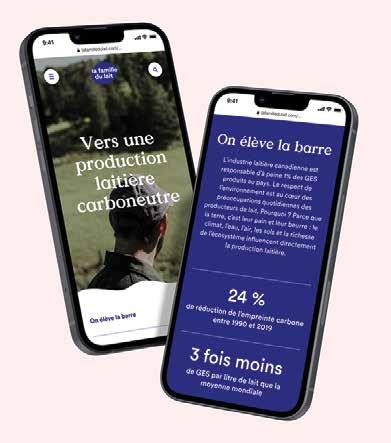
host and guests discuss the issues of the day while sipping wine and sampling Québec cheeses. Another is Arrive en campagne, a reality TV show where urban families spend time on a dairy farm learning what it’s like being a producer.

One thing that makes Gélinas such a successful marketer is that she trusts her team. For instance, she never goes on shoots. “I have very good people who I trust to do the job. I get involved in preproduction, making decisions about various aspects of the shoot, but on the day of the shoot, it’s in their hands. They feel greater ownership, and they take it seriously because they know I trust them to deliver the quality I expect,” she says.
Whether it’s the trust she has in her team or in the insights of the consumers she’s speaking to, Gélinas has created a collaborative environment that seems to perfectly serve her brand. So, while there may be challenges on the horizon – like what it’s going to take to keep the next generation of dairy farmers on the farm, ever-evolving environmental issues and even more competition in a crowded category – she’ll be ready, with the characteristic honestly and humility that has served her so well thus far in her career.
31 Winter 2023
ANDREW, CONGRATULATIONS ON BEING NAMED A MARKETER OF THE YEAR.
We think so every year. Glad to see it’s official. From your Buds at

ART, SCIENCE AND A LOT OF DISCIPLINE ARE CRITICAL FOR LABATT’S ANDREW OOSTERHUIS

Great marketing – or rather, the culture that engenders great marketing – should be a blend of art, science and discipline, asserts Andrew Oosterhuis, VP of marketing at Labatt Breweries of Canada.
In a competitive category, Oosterhuis says it’s tempting to try new things: innovation for innovation’s sake. But as a company with nearly 60 brands, it’s important for Labatt’s 82-person marketing team (including in-house agency draftLine) to create distinctive positions for each.
Which means discipline is paramount, especially when it comes to globally-known brands like Bud Light, Corona and Stella. “Freshly consistent” is the goal, he says. Be consistent in how the idea connects to the brand and its purpose – and then think about how to execute in a new way.
BY MIKE CONNELL
By way of example, Oosterhuis calls out Corona’s new entry in the increasingly competitive non-alcoholic space: Corona Sunbrew. Data and
33 Winter 2023
With nearly 60 brands on the roster, the key to success is crafting a unique personality for each - and calling on outside experts when you need a second opinion.
Bud Light has supported Pride for a decade (left), but this year it launched a weekend-long Pride Camp as well as limited edition Pride cans. Don’t get enough sun? Corona Sunbrew is for you (top right) – at least that’s what Labatt’s data suggested. Four-time Olympian Jayna Hefford (bottom right) worked with Bud to launch “This Game is for Us All” in support of the Professional Women’s Hockey Players Association.
the all-too-relatable work-fromhome realities during the pandemic led to the insight that people are generally spending way too much time indoors. So, the team came up with the idea to infuse a nonalcoholic beer with vitamin D.
“Corona was born on the beach,” he explains. “And [Sunbrew] literally gives you sunshine any time.” He describes it as a great example of matching innovation with brand purpose, and being distinctive yet consistent at the same time.

“Overall, we want our share of innovation to be larger than our share of category,” he says. But
what does that mean? It’s one thing to be innovative and come up with great ideas, even ones deeply connected with brand purpose, but it’s another to make sure the innovation delivers on what you’re trying to achieve – and sales aren’t the only barometer to consider.
He speaks about a brand’s DNA. When you have almost 60 of them, you need to have a disciplined (there’s that word again) portfolio strategy, which sometimes means pulling the brands apart to truly understand them.
He uses the U.S. versus Canada, and Bud versus Bud Light as an example. Bud is the number one
brand in Canada, while Bud Light is number one in the U.S. So how do you make the latter more popular here? Bud Light has always been a youthful brand that focuses on inclusiveness, whereas Bud has been firmly entrenched as the sports brand, deeply connected with a male sports audience, he explains.
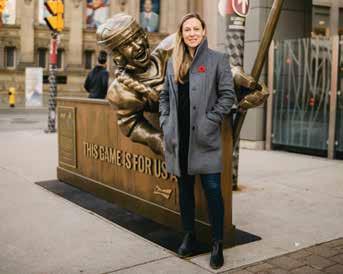
From a campaign perspective, he calls out Bud Light’s decade-long support of Pride here in Canada.
“But, this year, we dreamed bigger, hosting the brand’s first-ever Pride Camp, which was an LGBTQIA2S+ community- and ally-focused adult camp, where nearly 100 guests were able to celebrate embracing

34 strategyonline.ca








mediaincanada.com/subscribe All the media news you need. Replenish daily. Sign up for your free trial and stay connected with all the change afoot across the Canadian media scene.
their most authentic self, and where everyone felt welcome to the party just as they are.”
The effort was true to the brand’s DNA, distinctive purpose and personality. And the result of such executions is that the team has been able to grow Bud Light share 28 years in a row – it’s now on the verge of being the numbertwo beer brand in Canada, he sums.

Some of the work that Oosterhuis is most proud of is the Budweiser #TapeOutHate campaign with the Hockey Diversity Association. For Oosterhuis, it is an example of how a brand that has been consistently activating in the Canadian hockey space for years saw an opportunity to stand up and do more.
The #TapeOutHate film featured testimonials from players who have been the subject of racism. The initiative, in partnership with
Canadian Tire, sold 25,000 roles of tape, allowing fans and consumers to be part of the campaign and stand up against racism in hockey through the simple act of taping their stick with co-branded #TapeOutHate hockey tape.

“I say to my team all the time that you can’t just tell the world,” Oosterhuis says. “You have to act to make a difference.”
This action was a catalyst to dig deeper into a well-established brand and come out even stronger. “We’re Canada’s leading brewer. We have a portfolio of beloved brands. But I was really proud of how our team leveraged that scale and the love of our brands to build a more
Above: #TapeOutHate trended organically on Twitter, with the campaign generating more than 350 million impressions in less than two weeks.
inclusive category and country.”
As far as the challenges he faces on the horizon, Oosterhuis calls out the ongoing fragmentation of the industry. The impact of craft beer, the surge of “beyond beer,” ready-to-drink and seltzers create what Oosterhuis has coined “the complexity of growth.”
It won’t be easy to supply, sell and support a portfolio mix of nearly 60 brands. So, this is where the science comes in. It means streamlining SKUs, segmenting sales accounts across the country and digging into the data to better understand which brands in the portfolio “should be the focus to display and activate.”
In turn, that data – that science – allows them to consolidate marketing budgets and “bet on the brands that are going to be critical to driving our growth.” It fosters
“simplicity and focus to help face the complexity that we face in the industry,” says Oosterhuis.

In terms of where they can do better, Oosterhuis says they need to close the loop. “We don’t buy ads. We don’t buy executions. We buy media-neutral ideas,” he explains. “And a big evolution going forward will be to ensure the execution of these ideas is not just to drive reach and engagement to build equity, we also need to drive conversions.”
The real question, he asks, is how Labatt can use its first-party data to drive deeper consumer understanding to help deliver creative solutions that solve consumer problems and build engaged communities.
As far as how he connects all the dots to make this happen, Oosterhuis says he often turns to two groups to help: a brain trust and a creative council made up of non-Labatt (and non-Labatt agency) members, which were created by the Global Culture and Capabilities team in 2020. The trust is comprised of Matthew Bull, founder of SoloUnion and creative advisor to AB InBev; Matt McCoubrey, VP at SALT and Laura Serra, ECD at Mosaic. The council, meanwhile, includes names like Nancy Thomas, VP of brand and partnerships at Rogers; Craig McIntosh, CCO of Broken Heart Love Affair; Stacey Salmon, VP of Canada marketing at Jamieson Wellness; and Anne Marie Al Borno, head of experiential marketing at Shopify.

“The brain trust is not there to approve, but to improve ideas,” Oosterhuis says. The trust members provide feedback early on to make sure the ideas being considered make sense, will resonate and connect back to the brand purpose, at least from an “outsider’s” perspective. Both have helped on campaigns like #TapeOutHate.
Similarly, the creative council considers finished work. It’s like a jury, he says, who consider the strategy and execution of the idea.

“As a result, I feel like we’ve created a culture and capability around creativity,” so when it comes to goals like getting better at closing the loop, a system is in place designed to ensure that “in three to four years we’ll say we’re best in the world around creating insights and developing a deeper understanding that allows us to drive creative solutions to build and engage communities. That’s the journey.”

37 Winter 2023

You tell your mommy Yvonne Ziomecki-Fisher is a Marketer of the Year. Congratulations from your HomeEquity Bank family and partners.
HOW HOMEEQUITY BANK’S YVONNE ZIOMECKIFISHER SPARKED A POWER SHIFT
 BY CHELSEA CLARKE
BY CHELSEA CLARKE
Yvonne Ziomecki-Fisher wants you to know that HomeEquity Bank isn’t your grandma’s reverse mortgage provider – and neither is its marketing.
Okay, technically it is, but the fact of the matter is that the brand has evolved way past the outdated myth that a reverse mortgage is synonymous with the word “scam.”
“In the past, that’s something we dealt with, but with the amount of accessible information at everyone’s fingertips, as well as word of mouth, I don’t see it as a problem as much as it was 10 years ago,” says Ziomecki-Fisher, who’s financial marketing expertise spans several roles with American Express before joining HomeEquity Bank in 2013.
But that doesn’t mean she’s sitting on the sidelines when it comes to strengthening the 37-year-old brand’s image. During the pandemic, she and CEO Steve Ranson
39 Winter 2023
Representing a demo that often gets ignored or underestimated, she leads the charge in changing the tone.
Above: “Retire in the Home You Love” positions aging homeowners as in charge of their own destiny – with sass to boot.

authored Home Run, a book about reverse mortgages in Canada. In it, the pair describe success stories and provide commentary on real estate and wealth trends, while offering tips on how to talk with family about money – and explain how reverse mortgages work. “It’s been a big hit with our clients and partners,” she says.
And we know what you might be thinking: of course books would be a way to reach the brand’s target demographic of those 55 and older – these consumers aren’t exactly a cohort that you’ll find learning dances on TikTok.
But Ziomecki-Fisher says this is another area where outdated thinking runs rampant. “Many people don’t realize how advanced our digital marketing is because they underestimate how tech savvy older Canadians are.”

While many might remember HomeEquity Bank’s days-of-yore direct-marketing approach (think late-night cable ads with a 1.800 blue bottom third and plenty of B-roll), approximately 10 years ago, the brand embraced digital as a new channel for prospective clients. And just a few years later, HomeEquity Bank also partnered with agency Zulu Alpha Kilo to further develop its brand platform – a partnership that’s seen the development of awardwinning creative.
What’s perhaps most notable about that creative is the approach taken to get there.



In a TV spot as part of the series “Retire in the

strategyonline.ca
Congratulations, Yvonne Ziomecki! From your friends at Weber
HomeEquity Bank has given thousands of Canadians a reason to celebrate in the home they love. Your leadership and partnership inspire us every day! Strategy Top 5 Marketer
Shandwick.
Home You Love,” a campaign that helped HomeEquity Bank surpass one billion dollars in reverse mortgage originations in 2021 (a first in the company’s history), a young couple is seen eyeing an older person’s house, remarking about the time she’s got left before she sells so they can swoop in and purchase the property. Suddenly, “Doris” appears, letting the couple know she’s not going anywhere (“so get off her lawn!”). The campaign not only asserts this generation as possessing a feisty grit, but also empowers them to retain their agency – a far cry from infomercials depicting that someone has fallen and they can’t get up.
To further dispel myths surrounding reverse mortgages, HomeEquity has enlisted prominent figureheads such as Frank Abagnale, Peter Mansbridge, Patti Lovett-Reid and Kurt Browning to reach its target audience, featuring informative interviews across digital and social platforms.

The brand is also a strong sponsor for the Royal Canadian Legion, a union that began in 2018 and has gone on to realize some of its most compelling creative. Aligned on audience and values, together the

pair have entered the metaverse by connecting war veterans with gamers and e-sports, partnered with DoorDash to deliver re-created World War II field rations to consumers, and created a global virtual world in support of housing veterans.
Ziomecki-Fisher notes a favourite campaign from this partnership, “Letters Home,” which launched
Above: Peter Mansbridge is among the star-studded cast of loveable Canadians who help educate seniors on the benefits of a reverse mortgage.
41 Winter 2023
Above: Alongside the Legion, HomeEquity Bank launched “Orders of Sacrifice,” which made World War II field rations available for delivery on DoorDash. More recently, in their “Letters Home” campaign, the pair created replicas of wartime letters sent to their original addresses to remind Canadians of sacrifices made.


via OLV and across national OOH displays. In time for Remembrance Day, the campaign mailed replica letters written by Canadian Armed Forces during both World Wars to their originally intended addresses. She believes that this unique and powerful way to connect Canadians to the many wartime sacrifices made by Canada’s veterans won’t just raise awareness, but also lead to record donations at MyPoppy.ca.
You’ll notice that none of these strategies and campaigns paint a picture of HomeEquity Bank’s clientele as being in a position of inferiority or incompetence. Instead, its demographic is in a power position, having conversations with respected authorities of their generation and supporting causes that are close to their hearts.
Part of understanding how to ignite this power shift comes from Ziomecki-Fisher’s deep research. “We know a lot about our clients –
what they read, what media they consume and how they like to receive it – our strategies are developed to address that,” she says. She points to data-driven marketing and ongoing research to ensure the brand stays current.
As you’d expect, sometimes that research is very structured, enabled by a team that’s grown from four to 12 in Ziomecki-Fisher’s time. Research strategies include partnering with celebrated organizations that have a strong understanding of HomeEquity Bank’s client base, such as Canadian Association for Retired Persons, the Royal Canadian Legion and the National Institute on Ageing. But Ziomecki-Fisher also taps a secret weapon for the inside scoop: her mother-in-law. “I ask her about her favourite TV shows, and check out her magazine pile and Facebook feed,” she says.
This thread of embracing a more human side to marketing also extends to HomeEquity Bank as a brand. During the pandemic, Operation Warm Hug saw HomeEquity Bank’s employees calling clients to check in on their well-being. Ziomecki-Fisher remarks that this initiative was HomeEquity Bank’s values embodied: to help people achieve their goals and promote the belief that communities share the same purpose. “Initially, we thought we were going to help our clients by reaching out and having conversations,” she says. “But we all quickly realized it was a two-way street: our employees had the most wonderful conversations with clients who offered us advice and wisdom.”
Now after the height of the pandemic (as of when this issue went to print, anyway), the Operation Warm Hug tradition continues to be carried out by brand ambassador Kurt Browning.
It’s that ability to stay connected emotionally that drives Ziomecki-Fisher’s work – but it’s also what keeps her up at night. “On a macro level, [the challenges] are the same things we’re all feeling: postCOVID realities, work/life balance and the economy.”
As most marketers would attest, upcoming trends, budgets and blind spots round out her list of concerns. But when it really comes down to it, the evolution that she facilitates for HomeEquity Bank both inspires her and provokes more uncertainty as she keeps up with the level and pace of change. She wonders how people will cope and how their lives have changed after the last three years, and if they’ve got the right support systems in place.
But just as she finds a way to place power into the hands of those who need it, that shift also extends to her own work: “Market uncertainty keeps us on our toes. It ensures we don’t become complacent.”
42 strategyonline.ca
SHOPPER MARKETING REPORT

tabs on Canada’s changing path-to-purchase scene.
Keep
up for your free bi-monthly briefing on the latest research, consumer insights, retail trends and shopper programs. strategyonline.ca/subscribe
Sign
When we all work together the results are exponential.
Turning challenges into opportunities
Many lessons were learned over the past few years, and the brands that embraced change emerged stronger. The evolution of Canada’s top Indie agencies - as they partner with brands to respond to new market needs - provides a great litmus for what’s needed and what’s working now. Read on to see how they’re growing the tool kit, and helping brands greet the future.

SPONSORED SUPPLEMENT | S45 2023 List The
Borderless creativity







The 12-person Vancouver team is also thriving with account wins, including Destination BC and Save-On-Foods. The leadership team there has been strengthened with the hiring of new executive strategy director Erica Shalinsky from BBDO New York.
On the growth front in 2022, the agency launched Zulumatic, a modern, full funnel media buying and planning offering. “Because our media team sits next to world-class creative talent and Zulubot, our in-house content studio, it gives us the ability to be creative and drive effectiveness to a higher level,” says Alicia Petralia, head of media.
Zulu CMO Christine McNab says agencies with multiple offices are often beset with squabbling and politics, but that’s not the case for Zulu’s 150 staffers. “The founding vision has always been we’re one agency, no matter the location. I’m proud to see our borderless team collaborating as one to serve all our clients,” she says. Mroueh adds that “as a creative person, I didn’t want to move into markets such as New York until I felt we’d established our global creds.”
And on the global recognition front, the agency continues to rack up kudos, finishing among the top 10 international indie agencies at The One Show, D&AD and Cannes, winning six Cannes Lions in 2022.


For a third time, it won Ad Age International Small Agency of the Year Gold. Campaign US anointed Zulu as its Independent Agency of the Year, while in Campaign UK’s global competition, it won silver and bronze in the creative and Independent Agency of the Year categories among stiff competition from the world’s most sought-after shops.
The agency won a prestigious Gold Effie for Goldfish crackers’ “Feeding Imagination,” a national campaign celebrating kids’ creativity by showcasing their artwork and stories on platforms including OOH, a book, videogame, AR experience, and on social.
HEN ZAK MROUEH FOUNDED ZULU ALPHA KILO in 2008, part of his original vision was that global brands would one day reach out to the agency, regardless of its location.
This past year, Zulu brought this to fruition when it expanded from Toronto into offices in New York and Vancouver.


“The founding vision is coming to life,” says Mroueh, Zulu’s CCO and chairman. “But we’re not expanding to chase revenue. We’re doing it to chase great talent, because that’s the key to driving exceptional outcomes for our clients. We’re going where the talent is – it’s borderless creativity.”
To helm the New York office, Tim Gordon, formerly of Droga5 and a winner of top global awards, was brought on board as partner and CCO. And for the managing director role, the agency hired Meghan Mullen, who spent more than a decade at Wieden + Kennedy. “Meghan and Tim both share our goal for Zulu to become the world’s number-one creative company,” Mroueh says.
Months after opening in New York, the agency won two major US assignments for global brands. “Our first big project out of the gate has drawn on the combined talents of our entire agency from Vancouver to Toronto to New York,” Gordon says.
“It felt like we were firing on all cylinders, and if we were going to grow our talent base and agency, now was the time,” says president & CEO Mike Sutton. “We haven’t reached our founding goal of becoming number one in the world yet but we’re making great strides.”

Creative work includes The Micropedia of Microaggressions, an online resource and traveling exhibit of posters that highlight everyday expressions that are harmful to marginalized groups. It was launched by a Canadian coalition of diversity, equity and inclusion organizations and has had participation from 125 countries.
“Fixed-Rate Pizza,” an integrated campaign for Pizza Pizza, used a lighthearted tongue-in-cheek tone that plays on language from the mortgage industry. With a recession looming, consumers could “lock-in” their pizza cost for up to 12 months.

“Sound Shopping,” a campaign for Interac, used music to help people spend soundly in stores, and drums home the message that retailers often use music to encourage overspending.
“The momentum we’ve created over the last 14 years is paying off,” says Sutton. “We’ve got a borderless and brave team of Zuligans who are bringing unconventional creative solutions to our clients’ most complex business problems.”
 ABOVE: To launch Subaru’s latest model, Zulu developed a batch of Subaru BRZ Hot Sauce to give potential owners a “taste drive.” The campaign also featured a Snap AR gaming lens.
ABOVE: To launch Subaru’s latest model, Zulu developed a batch of Subaru BRZ Hot Sauce to give potential owners a “taste drive.” The campaign also featured a Snap AR gaming lens.
W
S 46 | SPONSORED SUPPLEMENT LIST THE
Zulu Alpha Kilo’s expansion is driven by its quest for brave talent
RIGHT: The Legion National Foundation and HomeEquity Bank reminded Canadians of wartime sacrifice with “Letters Home” – a fundraiser that had homeowners sent soldiers’ letters that were originally addressed to their residences.

FAR RIGHT: HomeEquity Bank teamed with Homes for Heroes, a non-profit that builds houses for homeless military veterans. Zulu built a virtual village in the metaverse that visitors could experience, and called upon Canadians to donate to help turn the virtual village into a real one.

ABOVE & RIGHT: The Micropedia of Microaggressions initiative, launched by Zulu for a coalition of diversity, equity and inclusion organizations, has included a traveling poster exhibit illustrating snubs and slights directed at marginalized groups.




BELOW & RIGHT: Pizza Pizza launched the first-ever “Fixed-Rate Pizza” to help consumers lock in the price of their pizza at the start of Canada’s skyrocketing inflation hikes.















ABOVE: The “Sound Shopping” campaign for Interac uses music to help people spend “soundly” in stores, and drums home the message that retailers often use music to encourage overspending.

 CONTACT: Christine McNab Chief marketing officer iNeedANewAgency@zulualphakilo.com
CONTACT: Christine McNab Chief marketing officer iNeedANewAgency@zulualphakilo.com
S47
ABOVE: Goldfish brought kids’ imaginations to life on a grand scale with Makayla’s printed storybook (shown), Teniayo’s massive mural, and Aiden’s interactive video game.
Meeting brand demand in health and food



Agnostic’s senior PR hires bring fresh eyes to growth categories
ONLY THREE YEARS AFTER ITS CREATION, strategic communications agency Agnostic has shifted from start-up to scale-up and had its most successful year to date, says president Sarah Crabbe.
“This year has seen us solidify what we’re about as an agency,” she says, noting the agency increased its firepower by expanding its employee count from single digits 18 months ago to almost 30 and venturing into healthcare communications.

Agnostic recognized the latter opportunity after receiving repeated requests as to whether it worked in health.







“There wasn’t any facet of communications that was not impacted by COVID-19,” she says. “It was a wide-reaching decision. The way we approach healthcare communications has forever changed and we want to be at the forefront of helping our clients navigate that change – especially with most people consuming healthcare information in a number of new ways.”

ABOVE: The choice of Beyond Meat burgers is one way people can reduce their environmental footprint. The image above was used as a part of a Toronto “ride-thru,” where Agnostic executed a burger giveaway to cyclists on Earth Day. The campaign ran across PR, XM, social and digital.

“We took a big leap into health with the hire of Nancy Dale as SVP,” Crabbe continues. Dale, who spent 16 years leading communications, stakeholder relations and branding at the Ontario Medical Association, is joined by Tenney Loweth as Agnostic’s director of health.
LEFT: Agnostic worked with influencers including Tasnim Rahman to help celebrate different holidays for Food Basics. Rahman showcased her Ramadan traditions, such as breaking the fast with piyaju.

S 48 | SPONSORED SUPPLEMENT LIST THE
Agnostic also brought in Sherri-Lyn Brown to lead its consumer practice. The former VP, national food sector lead at Edelman provides a senior consumer lens for brands such as Food Basics and Goodfood.
Targeted hires of established veterans with strong industry relationships has led to new clients and referral business.
The agency scored big client wins in healthcare and elsewhere, including work in nephrology (the treatment of kidney diseases) for Otsuka Pharmaceuticals, RBCx’s Dr. Bill medical billing app, and creating a new brand narrative for Northland Power. Other new partnerships include Harmon’s Craft Brewing, Manulife and the Child Development Institute.

As part of its foray into health, Agnostic hosted a webinar on the power shift in public health communications in the wake of COVID-19, hosted by medical reporter Avis Favaro. It addressed the trend of doctors increasingly becoming the bearers of healthcare news and opinion on platforms including Twitter and TikTok. There is a huge opportunity in using emerging science communicators as healthcare storytellers on social media, Crabbe notes.
Approaching things differently “has been a big driver in terms of our growth this year,” she adds.

For example, to ensure the Food Basics grocery chain was speaking to all its customers, Agnostic created a campaign that went beyond the traditional key holidays of Thanksgiving and Christmas.

“There are other holidays, like Ramadan, that are equally as important to celebrate,” Crabbe says. Agnostic partnered with influencers such as Tasnim Rahman, who was filmed shopping for Ramadan products in Food Basics stores, preparing meals and breaking the fast. This resulted in high engagement on social and in-store.
For Beyond Meat, Agnostic executed an on-brand product giveaway on Earth Day (April 22). The brand took over Toronto’s Woodbine Beach bike path and rewarded cyclists with “a more sustainably effective product – a burger from Beyond Meat.”
While other brands have been accused of greenwashing on Earth Day, the initiative aimed to show how small changes such as cycling can reduce people’s environmental footprint.
“This was about creating something that felt rooted in who they are as a company – feeding a better future,” Crabbe says.
“We talk about solving for – and not selling to – our clients.” The agency is at its best when it ensures its work is “rooted in insights and strategy and good solid thinking with clients as part of that journey,” she says, referencing its ethos: “better thinking, better results.”
In the past couple of years, the Agnostic approach won gold for Metro and Truss Beverage programs at the CPRS Awards, silver for Truss at the Strategy Awards, and it has been shortlisted for Strategy PR Agency of the Year two years running.
“We make sure the work we’re doing has a positive impact on our clients’ businesses,” says Crabbe. “We never lose sight of the importance of delivering strategically sound, culturally relevant work that sets the pace for our clients and ourselves.”
CONTACT: Sarah Crabbe President scrabbe@thinkagnostic.com
LEFT: HPSA and Agnostic uncovered that most parents weren’t keeping medications locked away from their kids. The agency partnered with Drug Free Kids Canada to highlight the importance of safely disposing or storing them. The campaign encompassed PR, social and digital.

RIGHT: Agnostic helped bring to life a new brand look, feel, and narrative for Northland Power, better positioning the organization as one of the market leaders that are “Transforming Power” for a sustainable future.

S49
Creative-driven M.O. serves as brand accelerant


123w’s talent-heavy focus fuels growth and expands scope









123w is approaching a 60-person headcount and a team of nearly 25 in Toronto, including recent key hires Allan Topol as CD, Justin Close as CD of digital and Colin Carroll as group strategy director. Across offices, it has also elevated Natalie Wu, Caroline Howson, Jaime Nilsson and Bianca Myers into new VP and managing director roles to lay the groundwork for future growth. Despite hiring rapidly, the bulk of the creative squad continues to be at the CD or ACD level.
Stocking up on talent and maintaining a senior creative team has enabled 123w to consistently deliver high-level work for all of its clients. “We do it efficiently and very well,” says Keith.
Both an advertising and design agency since day one, 123w now excels at brand transformations (think: complete overhauls) and brand accelerations (read: pouring gasoline on brands already on fire).
Breast Cancer Canada (BCC), formerly Breast Cancer Society of Canada, is an example of a brand overhaul, says Bofill. The non-profit had to modernize to stay relevant, so 123w started with the new name and an elegant visual identity that highlights the “beauty” of BCC’s mission. From there, it created a brand platform and launch campaign titled “Know More Breast Cancer,” based on the insight that too many Canadians weren’t aware of the ongoing breakthroughs in breast cancer research – even those to which their past donations had contributed.
COT KEITH OF ONE TWENTY THREE WEST (123W) believes the “rampant egos” once tolerated in the industry get in the way of putting out great work – and of having fun.
So back in 2003, when the CEO opened the doors to 123w along with his partners – creative directors Jeff Harrison, Rob Sweetman and Bryan Collins – they figuratively hung a “no egos welcome” sign in the humble East Vancouver garage that served as their office.
From day one, the founders wanted top talent, low overhead, and to actually enjoy the work. They committed to hiring the “best and nicest people” and maintaining a flat structure by having many creative directors.
In recent years, 123w has matured into one of the fastestgrowing shops on the indie scene. Following consecutive wins as strategy’s Small Agency of the Year, it outgrew the category for the first time in 2022. That’s after having opened a Toronto office in 2020 – under the leadership of partner and CD of design Mooren “Mo” Bofill – and gone on a hiring spree to support new wins with Plenty of Fish, HelloFresh, and Seattle Southside Regional Tourism Authority, among others.
On the brand acceleration side, Keith points to recent work for new client GeoComply, a Vancouverbased back-end technology provider. The company is already hugely successful, has massive market share globally and doesn’t need an ad campaign. Instead, the assist from 123w came in the form of creative educational materials, as well as a new illustrated visual identity recalling GeoComply’s role in “instilling confidence in every online interaction.”
Then there’s work that’s equal parts fun and attention-grabbing.
To support the launch of a brand refresh and updated app for Vancouver-born dating site Plenty of Fish, 123w created a “Gallery of Dick Pics” that cleverly reminded men not to share unsolicited photos of their genitalia on the platform. The digital gallery featured pictures of real Plenty of Fish users named Richard (some “big,” some “hairy”), which the ads described as “nice and wholesome guys” – in other words, the kind of people who would fit in well at 123w.

“We built the company on doing all the things we loved about the business with the people we loved doing it with,” Keith says. He believes it’s that devotion to people – both the agency’s staff and its clients – that is the secret to 123w’s success.
“We’re not weird. We’re not precious,” Bofill adds. “We just want to have strong relationships, collaborate well, and do great work that actually works.”
S
S 50 | SPONSORED SUPPLEMENT LIST THE
ABOVE: Using photos of real users named Richard, a “Gallery of Dick Pics” for dating site Plenty of Fish cleverly reminded all men not to share unsolicited photos of their genitalia.
ABOVE: As part of the “Small is Mighty” campaign for BC Children’s Hospital Foundation, the agency designed print ads that showcase children’s resiliency.
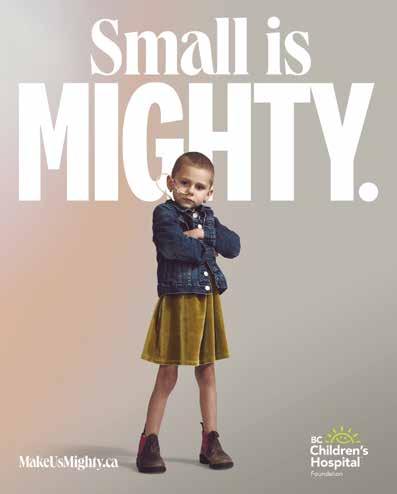
BELOW: To help showcase GeoComply’s global reach and role facilitating trusted online interactions, 123w crafted a new illustrated visual identity and educational materials that creatively shared the tech provider’s vision and mission.











ABOVE: For Breast Cancer Canada, 123W designed a new visual identity that highlights the “beauty” of the non-profit's mission and invites donors to “know more” about recent breakthroughs in cancer research.

ABOVE: For client Real Canadian Superstore, 123w created a spot that reimagined and incorporated visual elements of grocery flyers, giving the tactical format a more human feel.
 CONTACT: Scot Keith President and CEO scot@123w.ca
CONTACT: Scot Keith President and CEO scot@123w.ca
S51
Focus on audience and research serves changing brand needs
Push Media sees success with platform-specific creative strategy



ABOVE: For Canadian author Karina Fredericks’ children’s book series Grumbalina – about a young fairy – Push launched a redesigned e-commerce website and merchandise lineup.


TEN-YEAR-OLD


MEDIA MAVEN







PUSH MEDIA has tweaked its approach to creating campaigns, and that is paying dividends for brands. It also accounts for recent growth at the Toronto agency, according to president Kyle Verge.
Two years ago, the focus was on media at the Toronto-based agency, while creative was only a small part of the business. However, during the pandemic it became clear the traditional industry approach of starting with creative and then figuring out the most suitable media channels was no longer the best brand strategy. Verge says this is especially true given the current popularity of TikTok, which has become an agency priority.
Push responded to brands’ changing market needs by focusing first on audience and research and then figuring out what media channels to use, all prior to creative development.
Once they started looking at media before creative, and saw the impact of early collaboration, the agency
LEFT: In the “Long Time No See” campaign, furry friends welcomed Global Pet Foods customers back to stores that had been closed during the pandemic. The campaign was a winner for Push Media at the Summit Awards.

RIGHT: Push helped Bernstein Diet & Health Clinic reinvent its brand. The client had operated clinics across the country pre-pandemic, but changed its business model to go entirely virtual.

S 52 | SPONSORED SUPPLEMENT LIST THE
realized they needed to grow their internal creative team, and in 2022 nearly doubled in size. Verge says that growth proves the new approach is working.
“We found that when you have the creative and media teams working together from the beginning, the overall campaign is much more effective,” he says. “It’s made a world of difference because it allows us to have very specific creative executions for every channel.”
“Rather than trying to figure out how to take a 15-second spot for YouTube and trying to make it work on TikTok, we go to market with unique creative and messaging executions for each independent channel.”
Queen’s University is a long-time client that has seen success with the new approach. The school found that while its institutional branding and messaging was effective in print and other traditional media, it wasn’t breaking through to students on platforms such as TikTok.
The institution then gave Push the go-ahead to execute TikTok campaigns focusing on music and trending topics. “They embraced what TikTok is all about and now have tremendous success there,” Verge says. The “How to Party Safely” campaign garnered more than 700,000 impressions and a CPM of $4.66.
Push’s business grew nearly 50% this year and 166% over the last three years, landing the agency on The Globe and Mail's list of Canada’s Top Growing Companies. This boost was helped by new clients including Bernstein Diet & Health Clinic, Westdale Properties and CILAR, and additional work from existing clients such as the Canadian Internet Registration Authority and Clover Leaf.
The agency has moved into a new office – dubbed “the Clubhouse” – at Yonge and Shuter, transforming an abandoned building into
a space full of breakout and meeting rooms, lounge areas and a rooftop deck with barbecue.
“Rather than just an office with desks, it’s a place for collaboration,” Verge says. “It’s been great for growing the company culture for a business that’s been expanding so quickly.”
The agency’s creative M.O. shone during Pride festivities in Toronto, when it conducted a takeover of billboards in Dundas Square for online retailer Global Pet Foods featuring drag queens with dogs. Push also won a Summit Creative Award for “Long Time No See,” a campaign centred on welcoming Global Pet Foods clients back to brick-and-mortar stores after pandemic closures.
Verge notes that many national clients are accustomed to producing creative once a year during an intensive eight-to-10-week period, but “We’ve tried to coach our clients into changing that mindset.” To be effective with new digital channels requires looking at what’s trending, being agile and nimble, and producing creative –often at a moment’s notice.
To give clients a taste of what’s ahead, the agency is also setting up shop in the metaverse. As Dundas Square is steps away from Push’s offices, they recreated the space in the metaverse and put clients’ creative on the billboards.
“Clients can put on VR headsets and see what their brand could look like in that space,” he says. “The big focus for us is always bringing innovative ideas of ‘what could be’ to our clients.”
CONTACT: Kyle Verge President hello@pushinc.ca



LEFT: Push convinced Queen’s University to break the mold with TikTok campaigns such as “How to Party Safely,” which garnered more than 700,000 impressions and a low CPM of $4.66.
RIGHT: Push launched the Amazon store for Pharmacare’s Sambucol and Promensil products and created sponsored brands and display campaigns aimed at increasing orders from new customers. New-to-brand orders increased 385% versus 2021.

S53
Fresh lens; different perspectives
To do that, the agency is prepared to break the mold. It surprised many this year by forming a new 13-member board of directors, almost half of whom come from outside the industry, from fi elds including media, tech, AI, human resources, retail and fi nance.
“Having that external point of view to challenge our thinking is fuelling our ability to achieve our ambitions,” offers Jeremy Gayton, LG2 partner and president of the Toronto office. “We’re already seeing the benefits. Just the questions they’re asking are fascinating. Inviting new perspective around the table not only helps us progress as an organization, but also tackle our client’s challenges with a fresh lens.”
New perspectives are what LG2 is seeking – and delivering. It offered up an eclectic mix of work over the past year, including “Car Crash Flavoured” potato chips for insurer SAAQ – part of a hard-hitting campaign to dissuade Quebecers from driving while high. (The chips tasted of blood, asphalt and metal.)
It also created a tough national awareness campaign for Women’s Shelters Canada, led by a 60-second PSA that showed how women’s shelters also offer a wide range of services remotely and don’t require in-person visits to access them. It was backed by social, TV, radio and OOH with additional assets created for local shelters to use in their own campaigns.
LG2 has been just as busy on the design front – including new strategic brand positioning and visual identity for Catelli Pasta (“Made for the Modern Meal”) and for optical retailer New Look a fresh in-store experience with a complete redesign to better serve both customers and employees.
The agency also added a number of new accounts this year, including National Bank, Domino's Pizza Canada, Keurig, Dr Pepper, the Quebec Health Ministry, and others.


LG2 HAS EXPERIENCED REMARKABLE GROWTH OVER the past six years, doubling both its revenue and headcount in that time. The agency, which has offices in Montreal, Toronto and Quebec City, now has a staff of more than 500, serving 200-plus clients.

So given those numbers, can LG2 still be considered an indie?






“Let our size be proof that entrepreneurship can scale,” says partner and CEO Claude Auchu. “We hope to pave the way for other indies that, like us, see independence not as an infancy phase, but as a platform for sustained and sustainable success.”
The agency believes its growth will allow its business to be as comprehensive as possible. “We’re continuing to grow our capabilities in experience design, digital product development, ecommerce, employer brand and architecture,” says Auchu. “And we’re growing our national footprint to ensure our ability to tackle a single problem from various angles can be deployed in any market, coast to coast.”
Regardless of the ask, LG2 aims for breakthrough work. Gayton says clients come to LG2 looking to evolve, and to achieve those brand goals often means a deeper dive to see where change is needed. “For us to be able to do our best work, we need to be let in. We don’t do anything just on the surface. We believe our impact comes certainly over the short term, but more so over the long term. Creativity without consistency cannot lead to true progress for brands,“ he says.
Consider the agency’s newest work for Domino’s, which began as a limited tactical engagement but quickly grew to include much more. Historically, the brand’s Canadian efforts have been driven by US and international assets, but LG2 will soon be rolling out the brand’s first original Canadian work since the 80s. To really understand what the brand was all about meant LG2 staffers getting into a Domino’s kitchen to learn how to make pizzas and see how the businesses ran.

“You only get that info firsthand,” Gayton says, “so we look to clients to be comfortable inviting us into their world.”




This super-indie refuses to stay still.
“Our commitment to the future is about recognizing that we will never hit a point where we say, ‘Okay, we’re there,’” Gayton explains. “You’re either evolving or you’re regressing, and we refuse to regress. We’re committed to that constant pursuit of progress.”
Fuelled by outside input, LG2 pushes the boundaries of brand experience
S 54 | SPONSORED SUPPLEMENT LIST THE
ABOVE: LG2 worked with Domino’s Pizza Canada on “Pizza Over Everything,” a creative platform that declares Domino’s commitment to delivering Canadians a hot pizza every time – even after an apocalypse.
RIGHT: New Look turned to LG2 Architecture to design its new generation of stores and develop an eyewear shopping journey that integrates the latest technologies.


LEFT: LG2 created and brought the Beneva brand to life in all channels, including its digital platforms.
ABOVE: To reflect The Bay’s transformation and help it connect with a new generation of Canadians, LG2 evolved the look and feel of the brand and embraced the new brand signature “Live a Colourful Life.”


ABOVE: LG2’s “Made for the Modern Meal” brand work repositioned Catelli’s portfolio as an integral part of a complete meal. The products were given a bold, colourful new look to make them stand out and increase their taste appeal.



CONTACT: Jeremy Gayton Partner, president, Toronto jeremy.gayton@lg2.com









 ABOVE: “More Than” is a campaign platform developed by LG2 for Women’s Shelters Canada to improve understanding of the support available through the shelter system and to increase traffic and engagement at Sheltersafe.ca.
ABOVE: As part of their latest impaired driving campaign, LG2 and the SAAQ cooked up “Car Crash Flavored” chips –tasting of blood, asphalt and metal – to dissuade Quebecers from driving stoned.
ABOVE: “More Than” is a campaign platform developed by LG2 for Women’s Shelters Canada to improve understanding of the support available through the shelter system and to increase traffic and engagement at Sheltersafe.ca.
ABOVE: As part of their latest impaired driving campaign, LG2 and the SAAQ cooked up “Car Crash Flavored” chips –tasting of blood, asphalt and metal – to dissuade Quebecers from driving stoned.
S55
Leading brands to unexpected places






Ray’s female lens gives it a unique perspective on all aspects of its approach


BASED IN ST. JOHN’S, N.L., Ray has a decidedly unique perspective on the world of advertising. And not just because of the epic ocean views. As the only female led creative agency in Atlantic Canada, Ray is where clients and creatives go for an alternative to the mainstream and a different kind of relationship, posits president/ECD Jenny Smith.
Its unique point of view is its superpower, she says, flavouring everything from its approach to strategy and the way it uncovers insights to the adaptive, flexible, and inclusive culture it has created.





As Ray nears its 10th anniversary, Smith recalls that she had plenty of agency experience but no business background when she launched the firm from her kitchen table in 2013 – “just my phone and laptop,” she says with a laugh. But it was enough.


LEFT: Ray teamed up with Business and Arts NL to create “The Art of Going Out” to encourage patrons to get back out post-pandemic lockdowns. Ray developed the campaign using custom illustrations from artist Mike Butler inspired by Newfoundland’s beauty and whimsy. Animated short videos offer playful tips to audience members who may be out of practice.
 ABOVE: For the Newfoundland Distillery Company, Ray highlighted local ingredients such as seaweed, rhubarb, cloudberry and chaga mushrooms as components in “Rocktails,” beverage creations that invited drinkers to take a distinctly Newfoundland adventure. The campaign ran on digital, social, print and OOH.
ABOVE: For the Newfoundland Distillery Company, Ray highlighted local ingredients such as seaweed, rhubarb, cloudberry and chaga mushrooms as components in “Rocktails,” beverage creations that invited drinkers to take a distinctly Newfoundland adventure. The campaign ran on digital, social, print and OOH.
S 56 | SPONSORED SUPPLEMENT LIST THE
That entrepreneurial spirit is still very much part of the cultural fabric. Today with a staff of nearly 20 and clients all over Atlantic Canada, Quebec, Ontario, and the US, Ray remains fiercely independent as it evolves and grows.
“It still feels very young and ever-changing,” she observes. “And that’s a good thing – it keeps things fresh. We’re adapting to the market as our clients are, going through the same things, and finding a path that works for us. Everyone here is passionate about doing great work and having fun doing it.”
Among her primary goals at launch was to get rid of “all the layers and the hierarchy” and create a transparent agency based on great relationships. “The best work comes from the strongest relationships,” she says, “so ‘fit’ is something we take seriously – just being open and collaborative and honest. If you can’t trust your teammates, clients and partners, the work won’t come easy.”
One of Ray’s specialties, she explains, has been its ability to turn client insights into unexpected creative concepts. Take recent work for Steers Insurance. The “Brokers to the Rescue” spot casts insurance brokers in the unlikely role of heroes, charging across a pebbly beach to save the day. Providing the soundtrack is a hair-band power ballad called “Don’t Fall in Love” sung by rocker Paul Laine which generated buzz and radio play.
“We were inspired by Baywatch,” she sums. “It’s an unusual type of campaign for that category – but we built that trust with our client. Sometimes clients don’t realize how far they can push their brand.”
It’s an approach, she notes, that has worked with many clients, be they in the traditionally staid seafood category or crowded alcohol category. “It comes down to finding those insights and creating work that speaks to audiences in an authentic but also unignorable way,” she says.
Further making the case are recent campaigns for wildcrafted skincare producer East Coast Glow, True North Seafood, the NL Association of Fire Services, and the Newfoundland Distillery Company.
For the latter, Ray created “Rocktails” – a creative platform that celebrates hand-crafted spirits made with locally foraged ingredients including seaweed, rhubarb, cloudberry and chaga mushrooms – and injected the campaign with that unique Newfoundland spirit and humour. It ran on digital, social, print and OOH over six weeks and resulted in online sales 183% over the previous year (153% at NLC stores). Facebook reach was up 774%, Instagram up 4,900%.
The agency has landed a slew of new clients this year, including Steers Insurance, East Coast Credit Union, Business & Arts NL, engineering services company Wood PLC, Atlantic Lottery, and Tourism Southwest.



As for the future, Smith takes a pragmatic approach, letting opportunity guide her. But the core offering will always be the same.

“I like our size right now,” she says. “We’re a nimble, seasoned team that can bring a lot more to the table, including standout creative solutions. We understand strategy and the creative process better because we’ve been doing it a long time.”
“It seems like, more and more, clients are realizing they’ve never had this type of agency as an option before. And now that they’ve got a taste of it, they’re saying, ‘Yeah, bring it on!’”
 CONTACT: Jenny Smith President, executive creative director jenny@rayagency.ca
CONTACT: Jenny Smith President, executive creative director jenny@rayagency.ca


TOP FAR LEFT: To help the Newfoundland & Labrador Association of Fire Services reach a new generation, Ray created a series of animated videos to take the fear out of fire safety. Freddy the Fireball is a fun-loving emoji brought to life with the help of animators Stellar Boar and audio partner Toast + Jam.
TOP LEFT: Ray was engaged to refresh Quidi Vidi Brewing’s Iceberg beer brand and respond to the growing market desire for cans. The iceberg image references the ice giant that drifted into Ferryland in 2017, reinforcing that the beer is local through and through.
BOTTOM LEFT: Plant-based skincare company East Coast Glow crafts luxury skincare products using sustainable local ingredients. The “Wash Wildly” campaign – including digital, OOH and video – speaks to the brand’s mission to connect people with nature.
LEFT: Insurance can be pretty boring. But Ray likened having a Steers Insurance broker by your side to having your own lifeguard à la Baywatch – always there to watch out for you and ready to spring into action when you need them most. The integrated campaign includes television, cinema, radio, OOH, digital and social media.
S57
Growing to reach new heights
ABOVE: Rain created the “Get Ready” platform for Centennial College, highlighting how the school can help imbue valuable life skills, particularly in the areas of leadership and communication. A fully integrated campaign featuring Centennial students launched in the fall across broadcast, OOH, radio, digital and social.
PERHAPS IT’S NO SURPRISE THAT AN AGENCY NAMED Rain would have experienced so much organic growth this year – after evolving its working model to incorporate talent from coast to coast and expanding its core advertising specialty to meet brand demand.
Part of the growth at this full-service, Toronto-headquartered agency that launched in 2010 includes additions at the top. This past year saw the agency expand its leadership team as CEO John Yorke and chief strategy officer Laura Davis-Saville welcomed into the fold new MD Erin Wilbur and CCO Marta Hooper.
Wilbur came on board with a mandate to reimagine the agency for a post-pandemic world and rethink how the team is structured. “We’ve been building a smarter way of working, combining the best of a traditional advertising communication agency with a contemporary outlook on how we do it,” she says.
Rain’s retooling has included growing its design and branding focus – be it for identity systems or other brand work. New clients in that category include Downtown AutoGroup, GWL Realty Advisors
and Wolfpack Packaging. It’s also working on a rebrand of its own, which will roll out later this year.
The goal is to be able to collaborate closely with the client’s marketing team, wherever they happen to be, and be flexible enough to offer whatever help is needed. “We can action things for our clients quickly and surround the problem with the right people,” says Wilbur.
Accomplishing this is a decentralized team of about 40; beyond offices in Toronto, Calgary and Vancouver, Rain is now represented in Moncton, Thunder Bay and the Sunshine Coast. “A lot of our people are like Swiss army knives – they can do multiple jobs,” she says. “We attract people who want to be part of a small team in which they play a role across the board.”
Adds Hooper, “We’re no longer bound by this structural sandbox where you had a team working in an office. This new shift and mindset of working remotely has opened up our perspective. The quality obviously has to be of a certain level and we set that bar pretty high – but we’re finding new ways to collaborate.”










Brands are looking for a broader suite of solutions from Rain’s teams, which they are now set up to deliver both geographically and skillset wise. Dewalt Canada expanded the scope of its relationship with Rain, and the agency has become the power-tool maker’s social media AOR for Dewalt North America. Rain also took on rebranding efforts for Centennial College, along with new branding and campaigns for Nova Scotia-based telco Eastlink.
While the “how” may have evolved, the Rain philosophy remains the same.

“Everything we do serves growth. It’s the impetus and ethos behind our name, and we’re working with our clients to help them achieve it to an unprecedented degree,” Davis-Saville explains.

Rain itself has flourished this year with a total of 11 new clients onboarded, including luxury baby gear producer Cybex. It also won new government campaigns for Parks Canada and Environment and Climate Change Canada.
For Cybex – a new category entrant in Canada – Rain seized on the media momentum around Toronto’s newly minted Michelin star restaurants, creating “A Star for Mom,” which invited new mothers to Alo restaurant for an exclusive event catering to their needs, including stroller parking and nursing space.
Wilbur feels the steps the agency has taken position it to help brands take their own next step.
“We’ve been working with a lot of challenger brands with that growth mindset that have come to rely on us as an extension,” she says. “We have that ability because we’re small and have that entrepreneurial spirit – as well as that scrappy, humble mentality you get from a smaller team. That’s valuable to a lot of clients.”

Rain builds out its design and branding offerings to meet expanding demand
S 58 | SPONSORED SUPPLEMENT LIST THE
BELOW: In 2019, Rain was awarded the social media contract for the core tool brands in Stanley Black & Decker’s portfolio, including DeWalt, Craftsman and Irwin. This year, the agency became the social media AOR for Dewalt North America, and has already seen a bump in reach and engagement.


ABOVE: To help raise the brand profile of baby gear producer Cybex as a new category entrant in Canada, Rain created “A Star for Mom” – a Michelin dining experience for new mothers that catered to their needs.

RIGHT: Rain designed the packaging for Distillerie Noroi’s Canada 72 Dry Gin to celebrate the 50th anniversary of the Summit Series and “Canada’s Team of the Century.”

ABOVE: Eastlink approached Rain to help better position the cable provider and telco to consumers. Rain spearheaded creative development of Eastlink’s holiday campaign, which centred on the promise of “Uncomplicating Your Holidays,” leveraging a bold design aesthetic to cut through the clutter of holiday promotions.
 CONTACT: Erin Wilbur Managing director erin@therainagency.com
CONTACT: Erin Wilbur Managing director erin@therainagency.com









S59
Celebrating a decade of success





G&G Advertising’s approach blends wit with agility
G&G ADVERTISING, THE TORONTO AGENCY formerly known as Giants & Gentlemen, has taken the opportunity of its 10th anniversary to refresh its brand to better reflect its innovative, unexpected approach.



“We wanted to make it true to our personality today,” says founding partner Alanna Nathanson. “The new identity reflects our creativity and uniqueness. It's simple, vibrant and connotes a sense of endless possibilities.”
She adds, “Our philosophy is still ‘be brave, be decent.’ It's about doing meaningful, memorable work, while always having integrity. It all stems from who [co-CEO and CCO] Natalie Armata and I are.”


ABOVE: In a spot using vignettes of situations in which people claim to be too busy or tired to prepare a meal, G&G inserts beauty shots of different and unexpected Clover Leaf recipes, followed by the super, “Yes You Can!” to emphasize how quick and easy they are.


The agency of 25 has enjoyed a mix of established brand relationships and new business wins this year. It has seen accounts including Harvey’s, Enercare and RBC continue to grow organically, while gaining new assignments from Peoples Jewellers, burrito and taco QSR Quesada, and Bernstein Diet & Health Clinic. Other key accounts include the Canadian Internet Registry Authority (CIRA), Dr. Oetker, Clover Leaf and Fisherman’s Friend.
TOP LEFT: G&G extended its satirical use of Canadian tropes to get the message across for the Canadian Internet Registration Authority. This year’s campaign features a Canada goose strongly urging a business owner to choose a .CA domain over a .COM.

BOTTOM LEFT: In this Bernstein Diet & Health Clinic spot, a woman fashions a smoothie out of kitchen waste, house plants and potting soil and guzzles it, followed by a super that encourages viewers to instead “trust the experts” on weight-loss.




S 60 | SPONSORED SUPPLEMENT LIST THE
For long-standing client CIRA, G&G was tasked with finding a clever way to convince local Canadian businesses that the DOT CA domain is an effective way to attract customers. The first three years saw the humorous “Choose.ca” and “Don’t Be a Traitor” campaigns built around the “domain squad,” a group of geeky characters dressed like Mounties and park rangers.
This year’s creative is built around Canada geese, which, while proud symbols of Canada, can also be real jerks. In the 15- and 30-second spots, one of the feathered creatures aggressively persuades a pizza shop owner to go with .CA over .COM. The fully integrated “Choose success, choose .CA” campaign rolled out in October on traditional and connected TV and social and digital platforms.
Much of G&G’s most resonant work is comical. “We believe humour is the great unifier. It's a way to relate as humans, and for a brand to say, ’We get you; we see you,’” says Nathanson.
For Harvey’s, the message is built around the brand’s key differentiator: pick your own toppings. It’s one of the few situations where you get to call the shots, and so the “Burger Boss” campaign features a warehouse trainee who has just come back from Harvey’s, where she topped her burger the way she wanted (extra “Harv sauce”) and starts acting like a power-mad supervisor.
In a more serious vein, to help the Assaulted Women’s Helpline (AWHL) demonstrate the difficulty for victims to leave their abusers, G&G completely bricked in Toronto homes so they had no entry or escape points. Lawn signs read: “When you live with abuse, there’s no easy way out.” An OOH series carried

the same message. The campaign delivered the single biggest donation the AWHL has ever received.
G&G has made notable additions to its team. Agency veteran Sally McConnell, formerly of Public and Taxi, joins as VP business lead, along with VP business lead Mary Ruf, who has had stints at McCann and Young & Rubicam. Writer and ACD Graeme Campbell comes from Bleublancrouge and DentsuBos, and G&G also tapped the creative team of Matt Camara and James Ly, who both worked at Doug & Partners.
Nathanson says the agency has long prided itself for being nimble and resilient. She recalls her team boarding a flight to South America to shoot a campaign just as the president of the brand in question decided he wanted different scripts. “We managed to do rewrites in a matter of hours, incorporating our location,” she recalls. “We ended up with great spots and happy clients.”
With eyes on a happy work/life balance, all employees are free to work from anywhere. “We’re all about getting the best work out of people in the way that works best for them, and the pandemic simply heightened that ability,” notes Armata. “It’s about hiring the right people and trusting them. And with working from anywhere, the world is our oyster. Three of our new hires are from outside of Toronto. Our talent pool is as open as our client base.”
CONTACT: Alanna Nathanson Co-CEO and CCO a.nathanson@gandgadvertising.com



LEFT: To help the Assaulted Women’s Helpline illustrate how victims of domestic abuse can be trapped, G&G bricked in the windows and doors of houses and put up signs reading “When you live with abuse, there’s no easy way out.”
Passersby were asked to comment on camera to complete the message.
TOP LEFT: This Enercare spot features weird basement noises revealing an old furnace room transformed into an 80s dance club with disco music and colored lights, accompanied by the line “Furnace stuck in the past? Time for an upgrade.”

BOTTOM LEFT: To build on Harvey’s key differentiator of allowing customers to choose their own toppings, G&G spots humorously feature workers suddenly acting like bosses after being able to dress their burgers as they please.

S61
Creative efficacy for the win





Fuse Create rewired to form a culture where ideas come first
business. Fuse will be responsible for repositioning the brand, media buying, helping to create stakeholder and internal alignment, and boosting fundraising.
Other wins include Nestlé, Proximo Spirits, Tetley, Ricola Germany, Great Clips and Ontario Place.




Fuse is celebrating 20 years with no outside funding or talk of being consumed by a global or national agency. Its growth can be attributed in part to its 2020 rebrand from Fuse Marketing Group to Fuse Create.
“When we rebranded we had a mindset shift,” says CEO Stephen Brown. “The agency had long been operating with a lens of being highly productive, affecting everything from production, timelines, the brief, how success was measured, and the creative product itself. That approach was working, but it wasn’t winning.
“When we rebranded, the impetus was to establish a creative mindset that would make the efficacy and quality of the creative product the absolute priority. When you do that, [all other measurables] look different. We needed to evolve philosophically to build a reputation, attract the right talent and clients, and ultimately create a winning creative culture. This led us to ranking the #3 Small Agency in Canada.”
And it has helped Fuse grow. It is now 70 strong with key hires including veteran creative director Linda Carte, along with four new staff in the creative department, three on its social content team, and two in media.
Meanwhile, experiential marketing – which accounts for 30% of agency business – although challenged during pandemic lockdowns, has quickly rebounded.
One of the firm’s biggest experiential successes this year has been for Hilton Hotels & Resorts. Fuse built a 200-sq. ft. hotel room pop-up at the third-tee box at the Women’s Open and just off the eighth green at the men’s tourney.
ABOVE: For Hilton Hotels & Resorts, Fuse Create built a pop-up hotel room off the sixth green at the 2022 Canadian Open, giving six lucky golf fans the ultimate stay. The initiative earned 500M impressions and 2M social engagements.

APOP-UP HILTON HOTEL ROOM ON THE GREEN AT THE Canadian Open. Getting your “Everyday Voice” back with Ricola. Waking up refreshed after achieving your dream state with Sleep-eze. These are some of the campaigns that have helped make this past year one of Fuse Create’s strongest yet.
It all comes after Fuse took home Small AOY Bronze last November.
“We’ve had momentum since then,” says VP, executive creative director Steve Miller. “Hiring has grown in every department, and we’ve got a new office with a retail space for experiential events.” He adds business is up 30% over 2021.
Fuse continues to nurture established relationships with the likes of Maple Leaf Foods, Purolator, Schneiders, Air Miles, CIBC and Burnbrae Farms.
Among its new wins is Sinai Health, for which it has been named creative AOR, which will boost the agency’s bid to build an integrated

Says Miller, “Guests stayed overnight, they could sit and watch the tournament, and they had their own golf cart, gourmet meals, and a concierge. It garnered about half a billion media impressions and nearly two million social engagements.”
Another winning campaign was for Ricola. Known as a cough and sore-throat remedy, the brand suffered revenue losses as people weren’t getting as many colds during the pandemic. To bring back sales, Fuse developed “Everyday Voice,” a campaign that pivoted the brand from a cold remedy to a way of combating the hoarseness we all experience after days of virtual meetings.
Demonstrating new usage occasions drove incremental sales, and the repositioning tested so well in Canada that Germany is running a modified version of the campaign, exposing Fuse to the European market.

Internally, Miller and Brown are proud of the culture they have built. Brown points to the addition of mental health days to its vacation offering, as well as 24/7 Telus Health support for employees, and paying for the Calm app for those who want it. Such initiatives may explain the agency’s 80%+ retention level.
“We have carefully curated the culture with these small but meaningful touches,” he says. “This is one of the fundamental reasons for our success.”
S 62 | SPONSORED SUPPLEMENT LIST THE
ABOVE: Fuse Create developed Ricola’s first campaign targeting everyday voice care outside the cough and cold season. This award-winning campaign drove a 500% boost in sales in the GTA and has been picked up in the US and Germany.

ABOVE: Fuse research showed the true benefit of a sleep aid wasn’t the sleep itself but waking up in the morning feeling refreshed. So they dreamed up this category-defying campaign for Sleep-eze working alongside absurdist filmmakers The Perlorian Brothers, driving the highest sales in two years.

LEFT: Much of Fuse’s growth has come through social and the media planning and buying behind it. As a result, Fuse Create launched a content studio to work closely with brands such as Ricola, Air Miles, Old Dutch Foods, and Schneiders. The images shown for those companies ran across multiple social platforms.

ABOVE: After winning Sinai Health’s creative AOR assignment, Fuse’s first task was to dimensionalize the word “care” in the on-going “See What Care Can Do” campaign, putting a name and face to the care it gives. TV, OOH, print, radio, and paid social will bring that care to life. The next assignment is Mt. Sinai Hospital’s 100th Anniversary.
 CONTACT: Steve Miller VP, executive creative director steve@fusecreate.com
CONTACT: Steve Miller VP, executive creative director steve@fusecreate.com










LEFT: At any family holiday get-together, there’s bound to be an argument, be it over politics, boyfriends, religion, or COVID-19. So Fuse put together a deck of cards offering “52 Better Fights to Have” to help families make it through. It landed on tables across Canada and even at board game venue Snakes & Lattes.

S63
A model for our (budget-conscious) times
Round’s freelance structure affords access to senior talent
AS





FORMER LEADERS AT BIG AD AGENCIES,








Mike Davidson and Paul Riss have seen clients’ budgets get eaten by overhead costs – the kind that don’t usually make it into pitch meetings. At mega-agencies, clients end up paying for senior staff who oversee the work of mid-level talent.
That’s not the case at Round, the Toronto-based agency partner and managing director Davidson (former SVP at DDB) and partner and creative director Riss (former ACD at DDB) launched in 2018 with the idea that everyone involved is worthy of being a boss. Round hires bespoke teams of senior independent talent on a project basis, keeping overhead to a minimum. As Davidson puts it, “We create SWAT teams that go in and solve a problem.”

In most cases, the hired hands are award-winning, senior creatives who built their careers at traditional agencies. Still, Davidson or Riss (or, in many cases, both of them) personally lead every project. “You get Paul and I at the centre of everything without the bureaucracy of a traditional agency,” Davidson says.
Since launch, Round has worked with more than 160 individuals and companies on assignments for RBC, Subaru, Boston Beer Company, Harlequin, PayBright and many others. Its strong network allows it to handpick the right people for each project. “Our bench strength competes against any of the top creative agencies,” Riss says.
LEFT: Go Auto needed a fresh new data-intensive website to bring together over 50 dealerships across Canada and unify the brand at any digital touchpoint. It was the project that launched the agency’s new Round Digital division.

TOP LEFT: Harlequin believes women should unapologetically have the right to “feel.” Round, with the help of Polyester Studio, illustrated living watercolour animations of real women reading and experiencing a variety of emotions they might feel with a Harlequin story.

BOTTOM LEFT: The Terra project will change wildlife conservation with a large citizen science project. Round designed a logo of a fractal tree, representing the natural world as well as the product technology, which helps users hear and identify animal and natural sounds.
 ABOVE: Since Go Auto was launching an app to make vehicle ownership easier and see the digital car seller expand into BC, it added Vancouver Canucks captain Bo Horvat to its roster alongside Connor McDavid (shown).
ABOVE: Since Go Auto was launching an app to make vehicle ownership easier and see the digital car seller expand into BC, it added Vancouver Canucks captain Bo Horvat to its roster alongside Connor McDavid (shown).
S 64 | SPONSORED SUPPLEMENT LIST THE
Round’s model is an easy sell for startups and other small-tomedium-sized firms looking to access great talent while keeping costs down.



The agency executed branding for Nickson Living – a U.S.based startup offering custom, on-demand apartment furnishings – and developed the assets for “Yes. Everything,” Nickson's first integrated campaign. The work, featuring young professionals and families on the move – as well as spaces gradually filled with furnishings – drove so many leads that Nickson had to pause the campaign so operations could catch up.
Meanwhile, client BGC – the non-profit formerly known as the Boys & Girls Clubs of Canada – felt it wasn’t getting the attention it deserved. On the client’s limited budget, Davidson says, “We were able to give them the top work this industry can deliver.”
The relationship dates back to 2021, when Round developed a new identity for BGC, evolving its 120-year name to be more inclusive of the children and youth it supports. Since then, a series of campaigns has propelled BGC into the spotlight. “Unbelievable Impact,” its most recent effort, pulled inspiration from participant survey results to showcase the impact the organization’s clubs have on more than 200,000 children and youth every year.
Earlier, Round primarily won assignments based on its creative and strategic expertise, but the scope of work has broadened. More clients are entrusting it with assignments that span PR, media, production and website design, which accounts in part for Round’s growth of 50% to 75% per year since launch.
It is looking to build off that momentum with the recent launch of Round Digital. Though the agency has offered digital services for years, it has now formally expanded that offering as it begins to lead full website builds, from UX/UI through to development and delivery.
Round Digital’s first big assignment was the launch of a new website for Go Auto, one of Canada’s largest auto dealership groups. Having worked on successful campaigns for Go Auto since 2019, Round was selected for the year-long assignment following an agency review that included top US digital shops.
“Round came out on top based on the quality of its talent and overall costs,” says Duncan Cochrane, the brand’s SVP marketing. “We knew based on our experience with them that they would work collaboratively with our in-house team and deliver exactly what they promised without any surprises.”
Now, as Go Auto launches its latest campaign featuring hockey stars Connor McDavid and Bo Horvat alongside BodyBreak’s Hal Johnson and Joanne McLeod, Round believes the work speaks to its strength as an agency.
“We’ve had several clients since we started, but we believe most don’t benefit from retainers,” Davidson says. “Some have asked us about it, and I say, ‘Why?’ It’s much more efficient to go in and solve the problem together. And then wait for the next one.”
CONTACT: Mike Davidson Founding partner mike@weareround.com
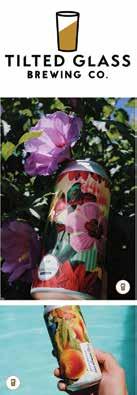
TOP LEFT: For BGC Canada’s “That’s Unbelievable Impact” campaign, Round played up results of participant surveys indicating 90% of BGC’s member kids “make better choices” because of its clubs.

BOTTOM LEFT: Birds and Beans Coffee is sourced from Smithsonian Bird Friendly farms, protecting the habitat of Canadian boreal nesting migratory birds. Round designed packaging to mirror migration flyways and included images of protected birds.
LEFT: Round illustrated the brand logo for Tilted Glass Brewing Co. to refl ect the exact angle at which you pour a perfect pint. For the packaging, a fresh digital collage approach gives each can a look and feel as unique as the brews themselves.

S65
Homegrown cannabis brand building cred
Sister Merci’s focus on research is spurring cross-border growth

included Tilray, Hexo and Organigram. For the latter, Sister Merci helped build Shred, which regularly tops the 10 most-searched brands on the Ontario Cannabis Store website, and co-created its recently launched value brand Holy Mountain.
One of the agency’s calling cards was its rebranding for Up Cannabis (owned by Hexo), which sat on the shelf without much support until Sister Merci got to work.






Tapping into that most Canadian trait, the agency took the opportunity to say “Sorry,” apologizing to cannabis customers for industry chaos marked by product shortages, high prices and lack of accessibility. The integrated campaign directly responded to feedback from social media and review websites, adding that the company had “stepped Up” its portfolio with higher THC offerings.

Sister Merci got its first taste of creating a brand from scratch with Cruuzy. Partnering with a licensed producer, it named the brand, designed the visual identity and developed the go-to-market plan. This helped get the brand listed across Canada quickly, and contributed to the first drop selling out in three weeks.
ABOVE: This comical campaign ran as in-store print posters and via organic and paid social. The creative was also featured in Kind Magazine and in digital advertorial format.
THE CANNABIS SPACE MAY BE ONE OF THE TOUGHEST sectors for marketing communications to find success, but for Sister Merci, it’s smokin’.
Positioning itself as a strategy-led brand-building shop specializing in cannabis marketing, Sister Merci touches all aspects of the business. From retailers to licensed producers to accessory companies, four-yearold Sister Merci has bootstrapped its way to the top of the crop.
Founded by ad industry veterans Paul Lawton (chief strategy officer), Katie Waterman (CEO), Amanda Wood (chief creative officer) and Andrea Dart (managing director), the leadership team also includes special advisor Stephen Headford. The firm is now 15 strong and growing.
Prior to cannabis’ 2018 legalization in Canada, Lawton was VP brand strategy at Cossette and led the launch of the Canopy Growth portfolio of brands. Prior to that he had a stint at Weber Shandwick, which is where he met the other Sister Merci founders-to-be. They got together to wield a deep understanding of marketing regulations in the Cannabis Act and how to develop compliant strategies and creative that can break through for cannabis brands.
“We come from big agencies, where you’re not often given the opportunity to come up with a new brand,” Waterman says. “Luckily, we’ve had the opportunity to do that dozens of times in the cannabis space.”
While Sister Merci is a boutique, it has full creative and strategy teams, in addition to client service and production. Key clients have



Lawton pitched in as temporary CMO to get the brand rolling. “It was challenging giving up one of our partners to work elsewhere, but that experience allows us to talk to clients with more credibility," Waterman says. “We have a better understanding of their operational pain points. It set us up for more success because now we can consult and troubleshoot across the entire business.”
Sister Merci also has enjoyed a successful partnership with Collective Arts Brewing. Working with Collective Arts’ internal creative director Steve St. Jean, Waterman says, “We co-created a beautiful YouTube spot that shows off all the incredible artwork and artists they’ve been working with.” The spot was part of an integrated digital campaign that reached over 17 million viewers and helped grow Collective Arts’ social footprint.
Research is key to the practice. Before he was in advertising, Lawton was a sociology professor, and has an appreciation for qualitative methods such as ethnography. The firm often employs social science PhD students to help with research, and at least once a week the entire Sister Merci team goes out to talk to dispensaries and budtenders to understand customer behaviour.
And they are immersed in cannabis culture. “Everybody [is learning to] grow their own plants from seed to harvest,” Waterman explains. “Then at our holiday party, everyone brings a sample and we have the Cannabis Cup to see who grew the best buds.”
The agency is now setting its sights on the US market after helping American brands Wyld and Cann enter Canada. Waterman adds that both have held the top spot in the US in their respective categories of gummies and beverages. “Building brands and markets that are just coming online from a regulatory standpoint is what we know best, and what excites us the most,” she says.


S 66 | SPONSORED SUPPLEMENT LIST THE
BELOW: Sister Merci collaborated with Collective Arts Brewing to promote its beer and spirits collections. They created a masterbrand digital campaign to drive sales and awareness over the summer months, centred around a short animated video that plays off the illustrations to bring the products to life.


ABOVE: The campaign for cannabis brand Cruuzy, which Sister Merci launched from scratch, ran as a combination of in-store posters and a 3D merchandising display featuring a wavy hand logo.
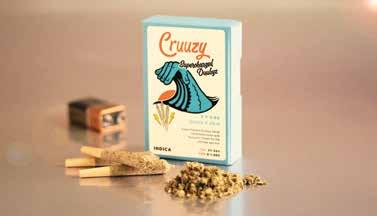

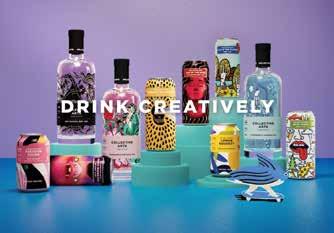 CONTACT: Katie Waterman Co-founder and
CONTACT: Katie Waterman Co-founder and












CEO katie@sistermerci.com

S67
Connecting for growth and the greater good A&C brings sales mentality to purpose-led PR









AMONG PR FIRMS, A&C SEES ITSELF AS UNIQUE. It’s a public relations shop that’s also a sponsorship and partnerships agency, with an eye on brands looking to make a better world.
Although the Toronto-based boutique has focused on PR since 2006, its do-good mission goes back 50 years, to when its primary business was securing sponsorship for arts and culture organizations.




That background goes far in explaining why A&C (which once stood for Arts & Communications) approaches its PR and media relations projects with a unique lens, says president Bonnie Hillman, who acquired the agency soon after she began working for it in 2000.
ABOVE: Toronto’s Union Station, undergoing a multi-year renovation, partnered with A&C to help bring its vision, new brand, and programming to life. The agency developed a strategy that ensured sponsors would create value-adds and enhance the overall experience, ultimately securing TD Bank.

“We see the media as partners, not as the other side of a transaction,” Hillman says, noting A&C has a long history of cultivating mutually beneficial relationships with media. “Because we were a sponsorship agency that worked on commission, as we still do, we have a sales mentality that serves us in the PR and communications side of our business.”
Hillman says that while A&C works with brands looking to give back in addition to selling what they’re



LEFT: A&C worked with Indigenous Fashion Arts on sponsorship for its return to an in-person festival in 2022. The agency developed a strategy to maximize sponsorship opportunities while upholding the integrity and vision of IFA and its communities. Partnership discussions resulted in A&C securing Rogers as presenting sponsor.

S 68 | SPONSORED SUPPLEMENT LIST THE
selling, it also has a diverse clientele – ranging from the City of Toronto to several alcohol, beauty and lifestyle brands.


“Because we’re small and work in arts and culture and with municipalities [also including Calgary], people come to us. We’re taking on more community-oriented projects and looking at the greater good that can come out of them,” she says.

Case in point: A&C helped the Indigenous Fashion Arts Festival find major corporate partners such as Rogers and Simons for its latest edition in June 2022.
“There’s a lot of interest from the corporate sector to participate in something like that, given the importance of highlighting Indigenous voices in all spheres,” she says. “It was as much about fashion as it was about elevating Indigenous voices, which is very relevant for corporate Canada.”
While many A&C staffers have media relations backgrounds, they’ve also worked in marketing, sponsorship, and philanthropy. “We funnel this variety of skill sets to think about how we can get media to pay attention, or get the right influencers to partner with us. It’s a mindset that makes us different,” Hillman says.
The agency has 12 employees, which Hillman says is ideal. Senior staffers are on hand throughout the entire process, from pitch to project completion.
“We like being nimble and effective and working with clients that are the same,” says Hillman. “There’s always going to be a new TikTok, so we approach projects with a clean slate.”
A&C recently collaborated with the Ontario Sports Network, handling media and influencer partnerships for “This is Your Sport,” a campaign aimed at sparking conversation about the barriers many people face in sports and recreation.
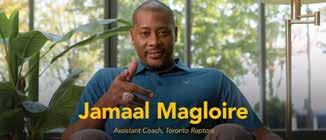
“Our goal was to contribute to a meaningful conversation around the barriers that hinder people’s participation – from discrimination, accessibility and safety to worries about COVID-19,” Hillman explains.
The influencer-led campaign partnered with notable athletes – including Olympic decathlon champion Damian Warner and Brock McGillis, one of the first openly gay men’s pro hockey players –and garnered coverage in the Toronto Star and Sports Illustrated It earned 12.9 million impressions, far exceeding KPIs.


Kids Up Front Toronto teamed up with A&C to build awareness for its organization, which gives tickets for arts, sports and cultural events to kids who otherwise wouldn’t be able to attend. The campaign included a video featuring well-known Torontonians recounting the first event they attended and the impact it had on their lives.

A media relations campaign for ArtworxTO – Toronto’s 20212022 year of public art that brought work by local artists to all corners of the city – gained about 50 million impressions.
Meanwhile, Hillman sees her team taking on a much greater leadership role. “I’m encouraging them to be a collective and have some ownership in this,” she says. “I’m excited to see what they will create.”
CONTACT: Bonnie Hillman President bonnie@acteam.ca
LEFT: A&C announced Alo Food Group’s ready-to-drink cocktail Espresso Martini Fizz with a “Night Luxe” themed launch party. The subsequent integrated PR and communications campaign leveraged the cocktail’s popularity to sustain interest through content creation, media hits, influencer product seeding and partnership opportunities.
LEFT: Kids Up Front Toronto breaks down access barriers to arts, sports, and cultural events for deserving kids across the GTA. To help drive awareness and individual donations, A&C enlisted inspiring Canadians for a campaign video in which they explain why entrance to these experiences is “#MoreThanATicket.”

S69

strategyonline.ca/subscribe Stay connected with daily brand news. Sign up for your free daily briefing and get context for all the marcom news, research & trends impacting the Canadian market.
Wexit

On the eve of his retirement from Queen’s University, industry vet Ken Wong sits down with Tony Chapman to talk marketing – the final installment of their popular strategy column.

Tony Chapman: Ken, what would you say was your superpower as an educator?

Ken Wong: I wonder if I have a superpower, other than trying to practice what I preach. We’re marketers. We make our living by getting people to behave in what we feel is their best interest. Isn’t that what a teacher is supposed to do?
The next generation will fight for jobs in the cloud, relevancy against AI and machines that will get faster, better and cheaper. How do we need to prepare them? Machines will always beat humans on efficiency issues, so don’t try to outdo it on that basis. Instead, accept that in some instances (like the activities accountants call “cost centres”) machines will win. It’s a good thing because it frees us to differentiate on the things a device is less well equipped to do: considering context, knowing how to frame a problem, factoring in considerations that are harder to quantify or where there isn’t enough data for statistical analysis, and being creative in every sense.
Machines play a game of probability, so number skills will be necessary for analytics. It isn’t a matter of knowing how to do the analytics, but rather knowing their assumptions and limitations. After all, if AI were perfect, we’d all kill the stock market. So, we need to teach our kids to excel at those skills and perspectives that cause us to question the recommendations and decisions of machines. Teach them what data to collect so machines can inform us, but never
delegate decision-making to them.
One final thing: no matter what tech we use, nothing beats the power of observation. How else do we know what to study?
You not only rode the changing waves of marketing, you also helped to define them. During your tenure, we went from mass (when the consumer was captive and enchanted) to “my”
it. Technology and the democratization of knowledge mean we will all be doing the same things. The key won’t be what, but how we do it.
Marketing is different from other business functions, but we manage it the same way. We would never allow staff to play video games on the job… but what if they are “creative staff”? You can’t regiment the creative process. We’ll aim to crack the code on how to engage staff, to show them that they have a purpose beyond making a sale or generating a tweet, that what they do matters. We need to think about our people as our target market and apply what we do as marketers to how we “sell” them on our strategies and tactics.
For example: we usually have one HR policy even though we know that different employees view work differently. Seniors might care about retirement policies, do 20-year-olds?
(where the consumer’s in control, contributing to the narrative and demanding more personalized offerings). What’s the next wave?
I don’t think our focus has changed or ever will. We have always known and wanted consumer sovereignty and more personalization. What’s different now is that the technology and information infrastructures let us do things we could never do before. So, we will always be drawn to technology that allows us to be more customer intimate.
The next wave won’t be strategic or technical. It will be when we learn how to manage marketing and the people who do
How do you want to be remembered most?
Head: an intellectual superpower on the bleeding edge.
Heart: someone who deeply cared.
Hands: a bias for action and never resting on your laurels.
I have always loved your three “H”’s and hope my brand incorporates all three. But they are tools that only gain value when used to produce an outcome. So, in the end, I hope I’ll be remembered most as someone who used whatever skills he had to help others realize their dreams, just as others helped me realize mine.
C
71 Winter 2023
KEN WONG is an award-winning educator, with 40 years spent as a marketing professor at Queen’s University. He’s a member of the Canadian Marketing Hall of Legends and winner of the Financial Post’s Leaders in Management Education award.
FORUM
TONY CHAPMAN was the founder of Toronto ad agency Capital
as well as Chapman Reactions. He’ s also host of Chatter That Matters, a weekly podcast that spotlights people who do extraordinary things, despite challenging circumstances.
THE SOCIAL MEDIA PARADOX
Icame across a video recently about the Golden Records sent into space by NASA via the twin Voyager spacecraft in 1977 [pictured left]. These time capsules were crafted with 116 images and, if found by intelligent alien beings, would provide an introduction to life on Earth. Carl Sagan, a major contributor said, “Perhaps [the aliens] would recognize the tentativeness of our society, the mismatch between our technology and our wisdom.”
 BY SHERI METCALFE
BY SHERI METCALFE
In media landscape presentations, I would remind clients of a similar thought, which is that technology grows at an exponential rate; much faster than our ability to anticipate its potential impact, of good or of harm. Social media is a contemporary example of this paradoxical dynamic.

So, the question becomes: What do we do about it, once we’re faced with such a mismatch?
SOME OF THE GOOD
Though it’s only existed a mere 15 years, it is hard to underestimate the meteoric rise of social media. It has brought communities together, united hobbyists and brave activists alike, while giving rise to critical issues such as #MeToo, #BlackLivesMatter and #EveryChildMatters.
New as of 2021, the Global Alliance for Responsible Media (GARM) report was born. Created by the World Federation of Advertisers and contributed to by all major platforms to eradicate harmful content, GARM is an encouraging proof-point that the platforms aim to build safer online environments. It includes a list of 13 banned topics such as child exploitation, voter fraud, vaccine misinformation, violent rhetoric and extremism.
Further, there is no question that education is of critical importance. Federal Public Safety Minister Marco Mendicino spoke at the G7 summit recently, saying disinformation is “one of the most pervasive threats to all our democracies right now.” Canada will host G7 members next year to, according to The Globe & Mail, “build up digital literacy to equip citizens with the skills to understand what is fact and what is not fact.” Government-led efforts here will help users understand that accessing news on social media, without
FORUM
Brands have led the charge for positive social change before. Is it time to lead again?
72 strategyonline.ca
paying close attention to the legitimacy of source, is not good practice.
SOME OF THE BAD
The harmful side of social media has percolated to the surface in recent times. Misinformation, disinformation, bad actors and bots, as well as the platforms’ algorithms have created echo chambers that result in real-world harm.
Twitter: Welcome to Elon Musk’s idea of “Citizen Journalism.” Musk’s takeover feels to me like some sort of bizarre kid’s birthday party: one part Squid Game, one part Lord of The Flies. Musk has re-instated banned accounts, like those of Donald Trump, Jordan Peterson and Kanye West. Fake tweets posted by parody accounts resulted in billions of dollars of market fluctuation for Eli Lily and Lockheed Martin. And then there is his fumbled attempt to create revenue via the blue checkmark. He’s also axed thousands of employees and given an ultimatum to those remaining to work hardcore or take a package.
TikTok: A 60 Minutes report of the difference between the platform in China versus North America was fascinating. Whereas anything goes in North America, in China, the content is mostly educational and access is limited. It has created a gap in users: Chinese youth want to become astronauts and American youth want to become influencers. Also, what is being done with user data? Some U.S. senators are even suggesting that TikTok be banned.
Facebook: The Cambridge Analytica scandal showed that FB allowed access to data without user permission. It pushed controversial content and disinformation, which ultimately gave rise to selfperpetuating echo chambers that pushed rabid conspiracy theories and a tsunami of false information. Frances Haugen, the so-called whistle-blower, summed it up by saying the platform prioritized “profit over safety.” As reported in the GARM report, FB blocks 99% of harmful content, but the platform is so large that even the 1% leakage is significant.

In his book, Reset: Reclaiming the Internet for Civil Society, Dr. Ronald Deibert from the University of Toronto’s Citizen Lab summarizes social media this
way: “A vehicle designed to capture and retain people’s attention while serving up a socially useful and entertaining platform has turned out to be a cesspool in which authoritarian practices prosper unhindered.”
During the past quarter, platforms have reduced staff, even in Canada. Will that lead to even less moderation, less oversight and less balance? Either way, it’s a concerning sign. (And you also have to question the manner in which these people were let go – “awful” and “unprofessional” are understatements.)
In no way am I suggesting a mass resignation, but I urge marketers to think about how they can influence and improve social media. I am encouraged to see paused Twitter advertising currently and, in the past, Facebook boycotted due to COVID misinformation. I suggest even more radical moves, like pulling out entirely until the social media platforms can ensure safety.
Brands might be shaking in their boots at the notion of not being able to rely on social media. But fear not. Fortunately, there are a myriad of options. In addition to .ca media websites, there are other kinder social media and streaming platforms. Given the advantages of realtime KPI output that the digital ecosystem offers, even “traditional” media is tackling the issue to provide such data. In fact, delivering consumer safety via media investment should be a brand imperative.
It’s time we align around a universally accepted notion of free speech. Is this even solvable? It would be a challenge, but there are guardrails around what is not acceptable, and the GARM report is proof that the industry and platforms can agree amongst themselves.
YOU’VE GOT THE POWER
What can advertisers do? In the past, marketers have played a pivotal role in shaping society. In South Africa during Apartheid, it was brands and marketers who led the protest via boycott. This was the spark, one could say, that caused that regime to fall.
Advertisers play a defining role in any platform’s success and/or survival. They are not utilities as some have suggested, but rather, advertising-funded vehicles. How much bad behaviour are brands willing to accept?
Here’s where my experience comes in. After a wonderful 34-year career in advertising, I expedited my resignation from a leadership role at Jungle Media in late 2020, a company and team that I have nothing by admiration and respect for, in no small part due to the societal harm caused by these platforms. I had had enough.
If a mismatch between technology and wisdom is inevitable, then we need to find a way to pump the brakes before damage is done. At the very least, we should be able to agree on an approach. It is crucial – this is not going to be the last time the marketing industry is faced with this sort of challenge.
Sheri Metcalfe co-founded Jungle Media in 2010 as part of Vision7 (now PlusCompany). During her media career, Metcalfe proudly and passionately led an award-winning team of media practitioners for blue chip clients such as IKEA, Nordstrom, NIKE, The Coca-Cola Company and General Mills, to name a few. Metcalfe was an active member of the advertising industry, serving on and chairing boards such as PMB, COMB and the CMDC. Metcalfe was recently awarded The Chairman’s Trophy by Vision7, the first individual to have received this coveted recognition.
73 Winter 2023
IF A MISMATCH BETWEEN TECHNOLOGY AND WISDOM DOES HAPPEN EVERY TIME, HOW CAN WE PUMP THE BRAKES BEFORE HARM IS DONE?
IF THIS DOESN’T WORK, I DON’T KNOW WHAT WILL.
I’ve tried email. I’ve tried voicemail. I’ve tried Teams, Slack - even a humiliating Post-It on your chair. Last week, I bestowed upon you that sad little clapping emoji, acknowledging that mediocre TV spot you posted on LinkedIn –all in hopes that you’d simply acknowledge my existence.
And yet, you remain elusive.
A squatter living rent-free in my mind. What do I have to do? Scream from the rooftops? Buy out a billboard? This entire magazine? Stand outside your window with a boombox like I’m fucking John Cusack?!?!
Maybe you enjoy making people feel small. Maybe you experienced a tragedy in your childhood that made you the way you are. Maybe this is all a game to you. A sick, twisted game…
Has it, for just one second, crossed your mind? What your complete inaction is doing to ME?! You think I don't see that stupid little green checkmark, day in, day out, that tells me you’re there, but you choose to make me feel invisible? You think I don’t see the idiotic GIFs you post daily in the Just For Fun chat? Everyone thinks you’re sooooo funny and charming and clever. But I see you for what you really are: A cold, cruel, calculatingly lazy mental terrorist!!!
I’m done waiting. I’m done being patient. Civil. This is your final warning. I’ve said it a thousand times, and I’ll say it once more. Only once more. For the love of God – do your timesheets
- Cheryl, finance
CC: Shauna and Hira, Edelman (both super up-to-date on their timesheets)
THIS BACK PAGE IS COURTESY OF EDELMAN 74 www.strategy.ca

Get corner office perspective in your inbox. Sign up for your free weekly briefing on how Canada’s brand leaders are responding to market challenges and acting on new opportunities. strategyonline.ca/subscribe MARKETING C-SUITE
























 BY WILL NOVOSEDLIK
BY WILL NOVOSEDLIK














































































 BY CHELSEA CLARKE
BY CHELSEA CLARKE



































 CONTACT: Christine McNab Chief marketing officer iNeedANewAgency@zulualphakilo.com
CONTACT: Christine McNab Chief marketing officer iNeedANewAgency@zulualphakilo.com

















 CONTACT: Scot Keith President and CEO scot@123w.ca
CONTACT: Scot Keith President and CEO scot@123w.ca



























 ABOVE: For the Newfoundland Distillery Company, Ray highlighted local ingredients such as seaweed, rhubarb, cloudberry and chaga mushrooms as components in “Rocktails,” beverage creations that invited drinkers to take a distinctly Newfoundland adventure. The campaign ran on digital, social, print and OOH.
ABOVE: For the Newfoundland Distillery Company, Ray highlighted local ingredients such as seaweed, rhubarb, cloudberry and chaga mushrooms as components in “Rocktails,” beverage creations that invited drinkers to take a distinctly Newfoundland adventure. The campaign ran on digital, social, print and OOH.








 CONTACT: Erin Wilbur Managing director erin@therainagency.com
CONTACT: Erin Wilbur Managing director erin@therainagency.com

























 CONTACT: Steve Miller VP, executive creative director steve@fusecreate.com
CONTACT: Steve Miller VP, executive creative director steve@fusecreate.com





 ABOVE: Since Go Auto was launching an app to make vehicle ownership easier and see the digital car seller expand into BC, it added Vancouver Canucks captain Bo Horvat to its roster alongside Connor McDavid (shown).
ABOVE: Since Go Auto was launching an app to make vehicle ownership easier and see the digital car seller expand into BC, it added Vancouver Canucks captain Bo Horvat to its roster alongside Connor McDavid (shown).








 CONTACT: Katie Waterman Co-founder and
CONTACT: Katie Waterman Co-founder and






















 BY SHERI METCALFE
BY SHERI METCALFE


